

3D CORAL REJUVENATING REEFS WITH TECHNOLOGY
FREE DIVING EXPLORING THE OCEAN DEPTHS
SLOW FASHION STYLE
THE FUTURE OF GOLF IS GREENER











3D CORAL REJUVENATING REEFS WITH TECHNOLOGY
THE FUTURE OF GOLF IS GREENER








In this edition of the Zimbali Estate Magazine, we embark on a journey rooted in the essence of conservation, a multifaceted concept that encompasses a broad spectrum of meanings and can be manifested in various forms. Whether it’s protecting ecosystems, managing resources sustainably, preserving cultural heritage, empowering communities, or using technology to address environmental challenges, conservation efforts are essential for safeguarding the planet and promoting a more equitable and sustainable future.
At the heart of our ethos lies a dedication to heritage preservation. We cherish the treasures of the past, such as the fascinating Voynich Manuscript, and honour the rich tapestry of history that defines our surroundings. Through our collective efforts we strive to safeguard the cultural legacy entrusted to us for generations to come, and innovate for a sustainable future, like the 3D printing of coral to aid in coral reef preservation, ensuring the continuity of marine ecosystems vital to our planet’s health.
But conservation extends far beyond the realm of ancient artefacts and future technology. It also encompasses the delicate art of nurturing relationships, both in business and in our personal lives, around the kitchen table, building bridges of empathy, understanding, and cooperation. Just as we cherish our natural surroundings, we must also cherish the bonds that connect us, fostering a culture of inclusivity and mutual respect.

Zimbali Estate stands as the epitome of ecoliving, a beacon of sustainability and harmony with nature. Yet, our message reaches beyond the confines of our gated community. We invite all who share our vision of a greener, more resilient future to join us in our conservation efforts. Whether through small everyday actions or larger-scale initiatives, each of us has a role to play in preserving the beauty and diversity of our planet for the generations that will come after us.
As you peruse the pages of this magazine, we hope that you will be inspired to join our quest to protect and nurture the world around us, and to embrace the spirit of conservation in all its various forms. Together, let us embark on a journey of stewardship and sustainability, leaving a legacy of preservation and prosperity for the world we share.


EXPLORING THE HIDDEN MYSTERIES AND WONDERS THAT LIE BENEATH THE SURFACE
In the realm of aquatic exploration, there is a breed of adventurers who push the boundaries of human capability and understanding. They are free divers, individuals who plunge into the depths armed with little more than their own breath and determination.
Free diving is the art of diving without the aid of breathing apparatus, and it is the oldest underwater sport in history. It was initially employed for practical endeavours such as harvesting seafood and seeking out treasures beneath the waves, and offers a unique blend of physical challenge, mental discipline, and aweinspiring encounters with the underwater world.
At the heart of free diving lies the pursuit of depth, an endeavour that carries both mystery and allure. The depths of the ocean, with their inky darkness and unfathomable pressures, have long captivated the human imagination. For free divers, these depths represent a frontier to be conquered, a realm where they can test their limits and discover the unknown.
One of the most remarkable aspects of free diving is its ability to reveal the hidden wonders of the deep. Unlike scuba diving, which relies on cumbersome equipment and limited time underwater, free diving allows for a more intimate and immersive experience. Free divers can move gracefully through the water, unencumbered by tanks and hoses, and explore underwater
One of the most remarkable aspects of free diving is its ability to reveal the hidden wonders of the deep
landscapes with a sense of freedom and ease. But with this freedom comes great risk, as free diving carries inherent dangers that demand respect and caution. The human body is ill-equipped to withstand the extreme pressures found at depth, and prolonged exposure can lead to serious injury or even death. Yet, for those who are willing to brave these risks, the rewards can be extraordinary.
One of the most celebrated figures in the world of free diving is Jacques Mayol, a French diver who achieved fame in the 1960s and 1970s for his incredible feats of endurance and exploration. Mayol set numerous world records for depth and duration, becoming the first person to descend below 100 meters (328 feet) on a single breath. His pioneering spirit and resolute, unwavering determination inspired generations of free divers to follow in his footsteps.

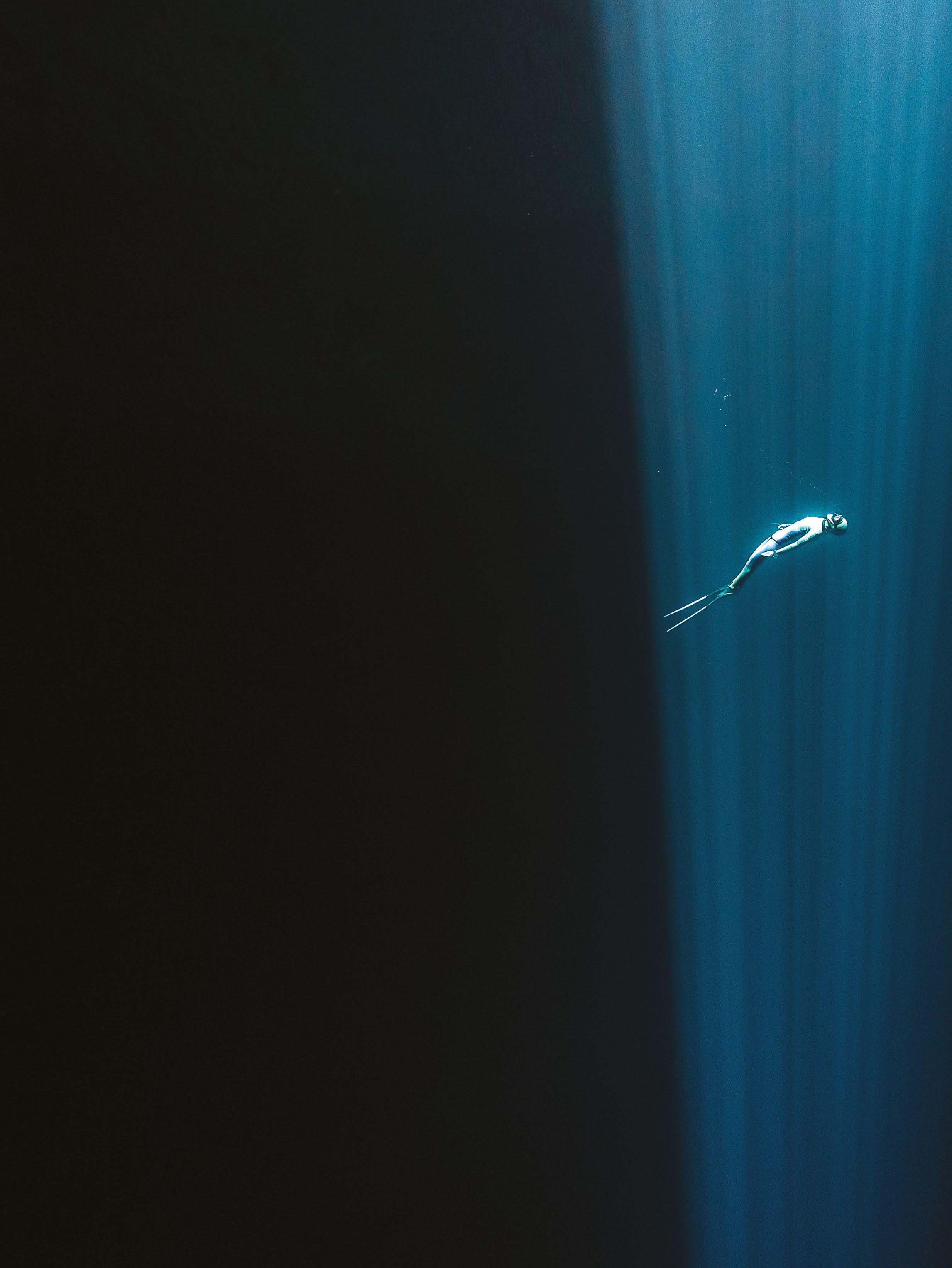
In more recent years, the sport of free diving has continued to evolve, with athletes pushing the boundaries of what was once thought possible, and today, it is considered the second most dangerous extreme sport in the world, after base jumping. It claims the lives of 20 free divers each year, just in the United States alone.
Even the athlete who many considered to be the greatest free diver in history, Natalia Molchanova, lost her life to the sport she loved. A Russian free diver known as the ‘Queen of Free Diving’ for her unparalleled skill and achievements, Natalia set multiple world records during her career, including a breath-taking dive to a depth of 101 metres in the discipline of constant weight without fins. Tragically, Molchanova disappeared during a recreational dive off the coast of Spain, and despite extensive search efforts, her body was never recovered, leaving the free diving community in mourning and raising questions about the risks of the sport.
Despite the inherent dangers, free diving offers a host of benefits for those who practice it with care and respect. It requires a high level of physical fitness, as well as mental discipline and focus. Free divers must learn to control their breathing and heart rate, as well as manage their buoyancy and equalisation as they descend into the depths.
In addition to the physical and mental challenges, free diving also provides a unique opportunity for personal growth and self-discovery. Many divers speak of the profound sense of peace and tranquility they experience underwater, as well as the deep connection they feel to the natural world. For some, free diving is not just a sport, but a way of life – a journey of exploration and enlightenment that extends far beyond the boundaries of the ocean.
Pushing the limits is a fundamental aspect of free diving, as divers continually strive to surpass their previous achievements and delve deeper into the unknown. Yet, along with this relentless pursuit, there is also a rediscovery of a sense of peace – a quietude that can only be found in the depths of the ocean. It is here, surrounded by the timeless beauty of the underwater world, that free divers find solace and serenity amidst the chaos of the surface above.
Free diving is a journey of exploration and enlightenment that extends far beyond the boundaries of the ocean.

In the end, free diving remains a pursuit shrouded in mystery and wonder, a testament to the indomitable spirit of human curiosity and exploration. Whether diving to unfathomable depths or simply exploring the reefs close to shore, free divers continue to push the limits of what is possible, revealing the hidden secrets of the underwater world one breath at a time.
Whether you are celebrating a milestone or special occasion, expressing appreciation or just spreading some joy, a meaningful gift demonstrates that you have put thought and effort into choosing something special.

This book is the ultimate gift for rugby enthusiasts, encapsulating the spirit and history of South African rugby in a captivating narrative. Mike Greenaway’s deep knowledge and passion for the sport shine through each page, offering readers an intimate journey through iconic moments, legendary players, and the triumphs and challenges that have defined Springbok rugby. www.thefiresidespringbok.com
Babylonstoren is renowned for beautiful gift presentation, and this delightful ‘Blushing Beauty’ collection is the perfect indulgent treat. From the fragrance of a Heuningbos candle lingering in the room, to the luxurious feel of delicately scented hand cream, this treasure trove of products is designed to spark moments of relaxation and joy. www.babylonstoren.com
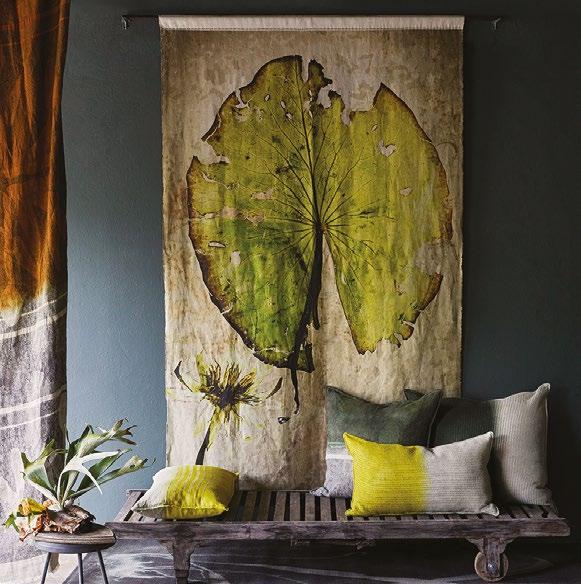

The Indlu Fern Panel is the quintessential wallhanging gift. It is a stunning decorative piece that is also a nod to the burgeoning trend of flora-inspired motifs. Indlu offers different design options to adorn a minimalist modern space or accentuate a rustic chic environment. The Fern Panel brings a touch of natural serenity to any space, and is an ideal gift for those who cherish aesthetic refinement and botanical allure in their homes. www.indluliving.co.za

The Joinery’s Overnight Travel Bag boasts ecoconscious construction, crafted from 24 recycled plastic bottles. Each custom-ordered bag features sumptuous leather handles for a touch of luxury. Fully lined with a convenient interior pocket, it’s tailored for seamless travel and weekend getaways. www.thejoinery.co.za
The timeless handcrafted design, eco-friendly construction, and cultural significance, make Veldskoen a meaningful gift tied to South African tradition. Suitable for casual outings or rugged adventures, for every family member, there is even a golf shoe for Veldskoen-loving golfers. www.veldskoen.com


The ultimate set of tools for every braai master, perfectly carried in a handcrafted genuine leather sack. The Jack Sack is designed to store and built to explore, containing handmade fire tools: two lengths of tongs, a fire blower and a fire paddle. This is the perfect gift for outdoor adventurers and braai enthusiasts. www.donkeylongtong.co.za
Crafted with meticulous attention to detail and imbued with the spirit of the Karoo, a Baby Heirloom Box serves as a timeless treasure that encapsulates the essence of family legacy. The hand-crocheted ‘Japie Skapie’ and wool slippers are perfect for a new winter arrival. www.karoofarmbox.co.za



2024 IS THE YEAR OF HARMONIOUS FUSION IN INTERIOR DESIGN


The world of interior design is undergoing a captivating transformation right now, blending elements from the past with futuristic innovations to create spaces that resonate with warmth, sophistication, and a touch of whimsy. As we embark on this journey through the trends shaping interior design in 2024, one thing becomes abundantly clear: the future of decor is as diverse and dynamic as the individuals who inhabit these spaces.
In an era where sustainability is paramount, eco-conscious design takes centre stage. From repurposed furniture to energy-efficient lighting solutions, homeowners are embracing eco-friendly practices without compromising on style. Expect to see natural materials such as bamboo, cork, and reclaimed wood adorning interiors, creating a sense of organic luxury. The colour palette echoes nature’s soothing hues, with earthy tones like olive green, terracotta, and sand dominating the scene.

In an increasingly interconnected world, cultural diversity is celebrated like never before. This year, interiors are adorned with artisanal craftsmanship, handwoven textiles, and eclectic decor pieces sourced from around the globe. From Moroccaninspired rugs to Japanese ceramics, every item tells a story of heritage and tradition. The colour palette reflects this cultural tapestry, with vibrant hues inspired by far-flung destinations – from the rich reds of Marrakech to the vibrant blues of the Mediterranean.

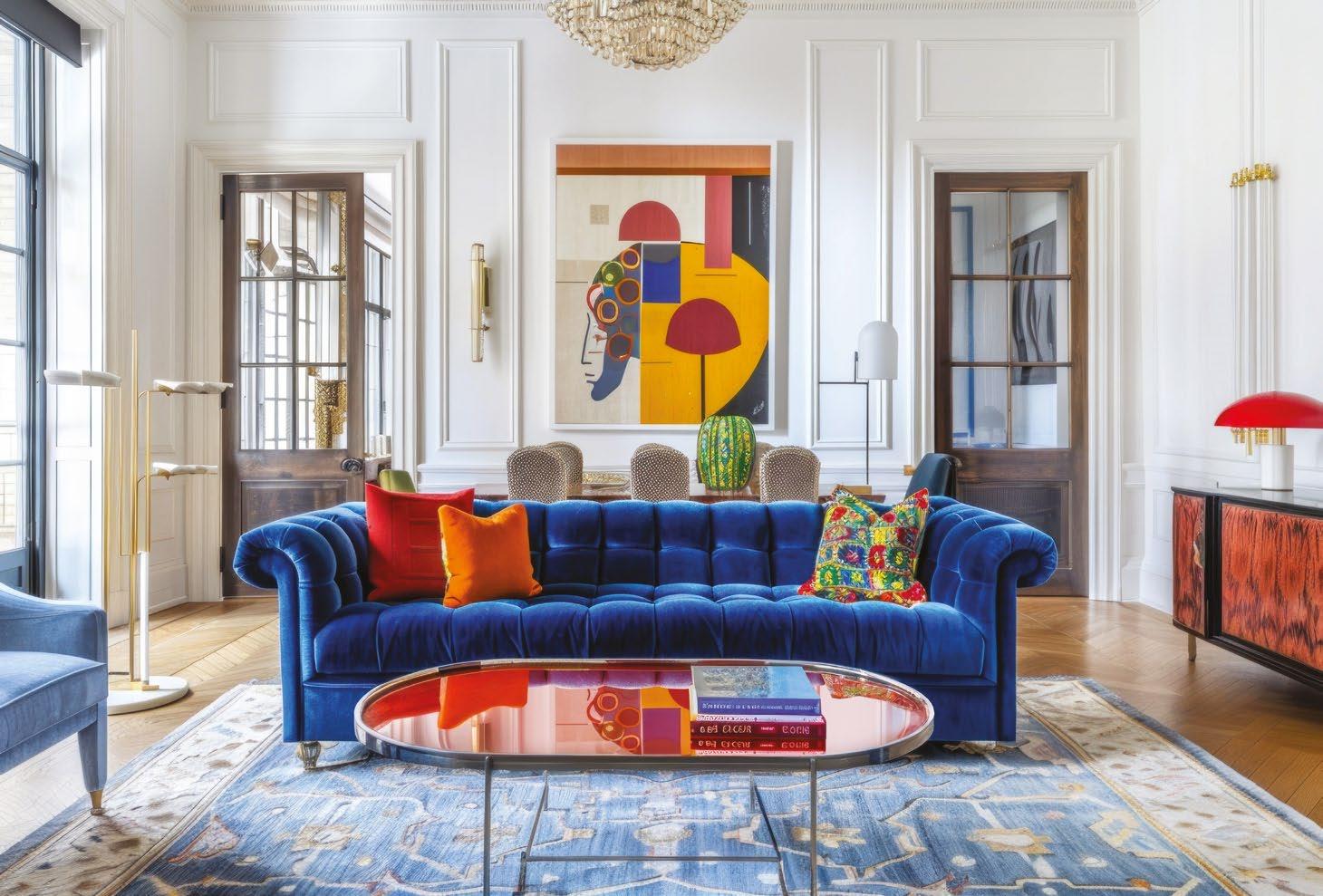
Bid farewell to minimalist austerity as maximalism experiences a contemporary revival. This trend celebrates boldness, mixing patterns, textures, and colours with fearless abandon. Think lavish velvet sofas, intricately patterned wallpapers, and ornate accessories that tell a story. However, this new maximalism is tempered with a modern sensibility, ensuring spaces feel curated rather than cluttered. Jewel tones such as sapphire blue, emerald green, and amethyst purple inject a sense of opulence, while metallic accents add a touch of glamour.
Handcrafted and artisanal elements are experiencing a resurgence, infusing spaces with a sense of warmth, authenticity, and individuality. From hand-carved wooden furniture to handwoven textiles and pottery, these bespoke pieces add a personal touch, and designers are championing the work of local artisans and craftsmen, showcasing their skill and creativity in every detail.


2024 celebrates the beauty of the past while also embracing the innovations of the present. Carefully curated vintage finds live in tandem with modern and even minimalist spaces, a juxtaposition that creates an eclectic yet harmonious aesthetic, where each piece complements the other to form a cohesive whole.
Additionally, designers are embracing vintage-inspired patterns and textures, such as floral wallpapers reminiscent of the Victorian era or geometric tiles evocative of the Art Deco period, to add depth and visual interest to contemporary interiors.

In an era marked by the relentless hustle and bustle of urban living, finding solace in the embrace of nature has become a fundamental pursuit. As our lives whirl with increasing velocity, the quest for peace gains precedence, shaping our living spaces into sanctuaries of serenity, where the boundaries between indoors and outdoors blur seamlessly. Floor-to-ceiling windows usher in streams of natural light, while indoor gardens and living walls breathe vitality into our urban abodes.
Central to the ethos of ‘natural living’ is the concept of biophilic design, which seeks to reconnect us with the natural world. Biophilic design brings in textures reminiscent of nature to adorn our interiors, inviting tactile exploration and nurturing our innate connection with the environment. It also draws on a palette that echoes the earth’s hues – tones of lush green, soft browns, and soothing neutrals wash over our living spaces, evoking a sense of calm and harmony.
As technology becomes seamlessly integrated into our daily lives, smart design solutions are enhancing both functionality and aesthetics within the home. From voice-activated assistants to smart appliances, technology is seamlessly woven into the fabric of modern interiors. However, this digital integration is balanced by a desire for tranquility and mindfulness. Soft, muted tones like blush pink, serene blue, and gentle grey create a calming atmosphere, while simple furniture and clean lines foster a sense of clarity and serenity.




RECLAIMING THE DINE-IN KITCHEN CAN ENRICH FAMILY LIFE
WORDS CATE STEVENSON
In the ever-evolving landscape of home design, it seems that everything comes full circle eventually.
Nowhere is this more apparent than in the heart of the home – the kitchen. Decades ago, the dine-in kitchen with a central dining table was a staple of family life. However, as the desire for more storage and sleeker aesthetics took precedence, the beloved kitchen table was gradually replaced by the imposing presence of the kitchen island.
But as trends shift and priorities realign, the pendulum swings back towards a simpler, more meaningful way of living. The island, once hailed as the epitome of modern convenience, is now making way for the resurgence of the kitchen table. In today’s homes, we’re witnessing the integration of dining tables into open-plan kitchen spaces, reclaiming the kitchen as a gathering space where families can come together and connect.
At the heart of this movement lies the concept of ‘kitchen table wisdom.’ Much more than just a design choice, it’s a celebration of the human tradition of shared experience. Around the kitchen table, life unfolds in all its power and mystery. Here, amidst the clatter of dishes and the aroma of home-cooked meals, we’re reminded that the intangible moments – the laughter, connections, and conversations – are the ones that sustain and enrich our lives in immeasurable ways.
The rationale behind the dine-in kitchen extends beyond mere functionality. It’s about creating a space where families can thrive, where children can do their homework or engage in lively conversation while parents prepare meals. It’s a place where guests are welcomed with open arms, invited to relax, lend a hand, or simply share in the joy of communal cooking.
But beyond the practical benefits, there’s a deeper significance to reclaiming the kitchen table as the focal point of family life. In today’s fast-paced world, where technology often dominates our attention and relationships can feel fleeting, the act of gathering around the table takes on profound meaning. It’s a deliberate choice to turn off the television, silence our phones, and turn to each other – offering those we love the most our undivided presence.
Studies have shown that consistently sharing meals together as a family is one of the most transformative and healthy things we can do. It fosters communication, strengthens relationships, and creates a sense of belonging and security. In the simple act of breaking bread together lies the potential for profound transformation, and in a world filled with divisiveness, turmoil, and an endless list of tasks vying for our attention, the kitchen table can become a sanctuary – a safe space to come together, share meals, exchange stories, laugh, heal, and nourish body and soul.
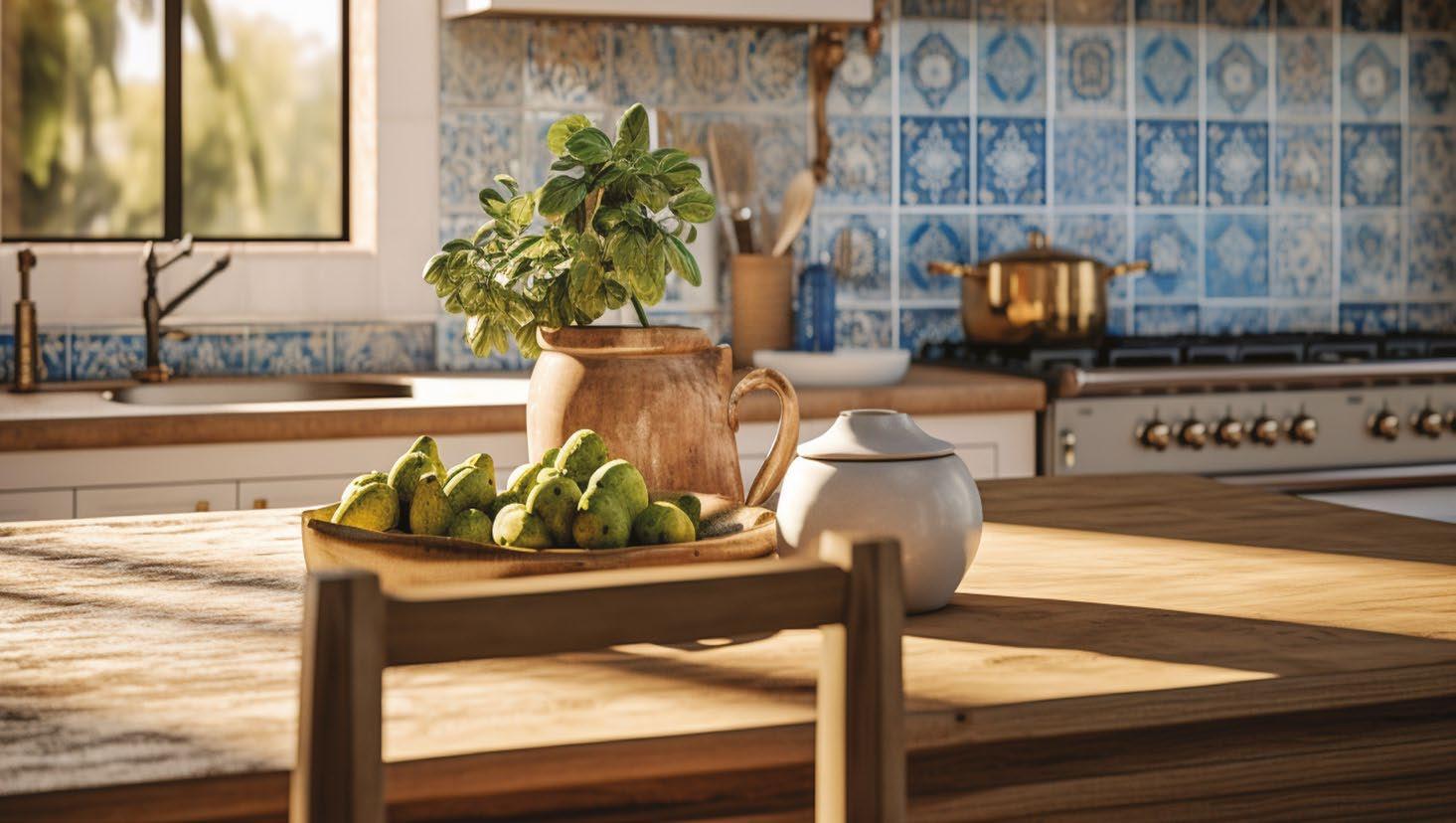
Everybody is a story. When I was a child, people sat around kitchen tables and told their stories. We don’t do that so much anymore. Sitting around the table telling stories is not just a way of passing time. It is the way the wisdom gets passed along. The stuff that helps us to live a life worth remembering.
RACHEL NAOMI REMEN




INNOVATIVE DESIGNS AND SUSTAINABLE STYLES REDEFINE THE FASHION LANDSCAPE WITH A BLEND OF ELEGANCE AND CONSCIENTIOUSNESS




As winter settles in, the fashion landscape for 2024 and 2025 embraces a nostalgic nod to heritage charm. Picture countryside retreats with crackling fires and cosy corners – that’s the essence of this season’s style. The pairing of classic heritage tweeds and herringbones with the rustic allure of plaids evokes a sense of old-world sophistication. Complementing these timeless patterns are the intricate weaves of Aran and Argyle knits, adding depth and warmth to the ensemble. It’s a harmonious blend that effortlessly conjures up images of country-house weekends, where comfort meets elegance in the most captivating way. Autumn and winter fashion for this season – and seemingly next – invites us to embrace the familiar comforts of the past while adding a contemporary twist, ensuring both style and substance for the colder months ahead.
Autumn and winter fashion also takes a bold turn, with the rich and sumptuous hues of burgundy and red wine dominating the catwalk colour palette. Evoking the luxurious depth of a fine Bordeaux, this sophisticated shade adds an air of opulence to any ensemble. Whether you’re wearing a plush velvet blazer, a sweeping wool coat, or a sleek evening gown, burgundy commands attention with its deep, romantic allure. This season, designers are infusing their collections with this decadent hue, offering a myriad of ways to incorporate it into everyday wardrobes. From statement accessories to headto-toe monochrome looks, burgundy reigns supreme as the ultimate colour choice for those seeking to make a chic and memorable statement, while keeping out the cold weather, during this autumn and winter period.
The high collar trend exudes regal elegance and refined sophistication, drawing inspiration from Victorian era grandeur. Seen on runways and urban streets alike, these exaggerated necklines adorn tailored blouses, flowing dresses, and structured coats, instantly adding drama to any outfit. Expect variations ranging from romantic ruffles to sleek mock necks, offering versatility and timeless charm.

Embracing the sustainability ethos, designers are championing faux materials as a key trend for the winter season. From faux fur coats to faux leather accessories, the emphasis is on cruelty-free and ecoconscious alternatives that still exude luxury and style. This shift towards faux materials not only reflects a growing global awareness of the impact of fashion on the environment but also offers a nod to the innovative techniques and materials available in the modern age. As we strive towards a more sustainable future, the winter fashion trend of faux celebrates both style and conscience, proving that fashion can be both chic and environmentally responsible.
Chunky boots continue to make a bold statement this season, solidifying their status as a timeless trend. They effortlessly blend style and practicality, offering both fashionforward flair and reliable functionality. Whether paired with a flowy dress for a bohemian vibe or juxtaposed with tailored trousers for an edgy twist, chunky boots remain a versatile staple in any wardrobe.



RICH IN TEXTURE AND STEEPED IN TRADITION, THIS SEASON SEES A FUSION OF TIMELESS ELEMENTS.

SUSTAINABLE STYLE IS ALWAYS IN VOGUE
In a world where trends quickly come and go, there’s a quiet revolution happening in the realm of fashion.
The dark side of fast fashion, including sweatshop labour and exploitative working conditions, has come under intense scrutiny in recent years. As a result, consumers are seeking out brands that prioritise fair wages, safe working conditions, and transparent supply chains. Slow fashion brands, with their emphasis on ethical production, are filling this demand for accountability and integrity in the fashion industry.
It’s no longer about flashy logos or fleeting fads, but instead it’s about embracing sustainability, ethical production, and timeless style. We’re entering the era of slow fashion, where quality reigns supreme and conscious consumerism is on the rise.
Slow fashion is more than just a passing trend; it’s a fundamental shift in the way we approach clothing. Stemming from the broader slow movement, which advocates for a slower, more mindful way of living, slow fashion puts the focus on craftsmanship, durability, and environmental responsibility.
At its core, slow fashion is a rejection of the fastpaced, throwaway culture perpetuated by the traditional fashion industry. Instead of churning out cheap, mass-produced garments destined for landfill, slow fashion prioritises quality over quantity, encouraging consumers to invest in pieces that are built to last.
This year, slow fashion has officially gone mainstream, with more and more consumers embracing its principles. There are a few key factors driving this shift in mindset, including environmental awareness, ethical considerations, quality over quantity and cultural shifts.
With climate change and environmental degradation at the forefront of global consciousness, consumers are increasingly conscious of the impact that their purchasing decisions have on the planet. Slow fashion offers an eco-friendly alternative to the wasteful practices of fast fashion, with brands focussing on sustainable materials, ethical production methods, and reduced carbon footprints.
In a world saturated with cheap, disposable clothing, there’s a growing appreciation for wellmade pieces that stand the test of time. Slow fashion encourages consumers to buy less and choose better, investing in high-quality garments that not only look good but also last longer. In an era of Marie Kondo-inspired minimalism, the idea of curating a thoughtfully curated wardrobe of essentials is more appealing than ever.
As societal values continue to evolve, there’s a growing desire for authenticity, individuality, and self-expression. Slow fashion celebrates craftsmanship, heritage, and unique design, offering an antidote to the homogenized, massproduced styles of fast fashion. From artisanal textiles to locally made goods, slow fashion allows consumers to connect with the stories behind their clothing and express their personal values through their fashion choices.
As we look ahead to the future of fashion, it’s clear that slow fashion is here to stay. It represents a significant paradigm shift in the way we approach clothing, and in a world that is constantly in flux, embracing the principles of slow fashion allows us to make more mindful choices for ourselves and the planet.

Right Classic coats and jackets look good with many different outfit combinations, and last longer.







There is a range of items trending in fashion circles, aligning with the principles of slow fashion:
Organic and sustainable fabrics made from organic cotton, hemp, linen, and bamboo are increasingly popular due to their eco-friendly properties.
Classic outerwear pieces like trench coats and leather jackets are making a comeback, and their timelessness reduces the need for replacements. At the same time, vintage retro-inspired pieces from past decades add a unique flair to modern wardrobes while reducing waste and promoting circular fashion. Embracing vintage and thrifted clothing is a sustainable and stylish choice.
Artisanal knitwear made from natural fibres showcase traditional techniques passed down through generations, while shoes crafted from high-quality materials by skilled artisans are highly sought after. From leather boots and loafers to sneakers made from sustainable materials, slow-made footwear combines style with ethical production practices. Handmade accessories like leather bags, woven belts, and ceramic jewellery add a personal touch to outfits, while also supporting independent artisans.
Capsule collections consisting of a curated selection of versatile pieces are gaining popularity among fashion-conscious consumers. These collections emphasise quality over quantity.
Minimalist wardrobe essentials such as white shirts, tailored trousers, and little black dresses never go out of style. Investing in well-made basics allows for endless outfit combinations and promotes a simpler, more intentional approach to fashion.
On the other end of the spectrum, designers are repurposing vintage textiles and pre-loved clothing to create unique, one-of-a-kind garments. Upcycled fashion not only reduces waste but also celebrates creativity and resourcefulness.
Consumers are increasingly seeking out transparent and ethical fashion brands that prioritise sustainable practices. Supporting these brands aligns with the values of the slow fashion movement and drives positive change within the industry. In recent years, South Africa has seen a surge in slow fashion brands, aligning with global trends towards ethical production, quality craftsmanship, and timeless design – which is reshaping the fashion landscape and fostering a culture of mindful consumption and responsible living.
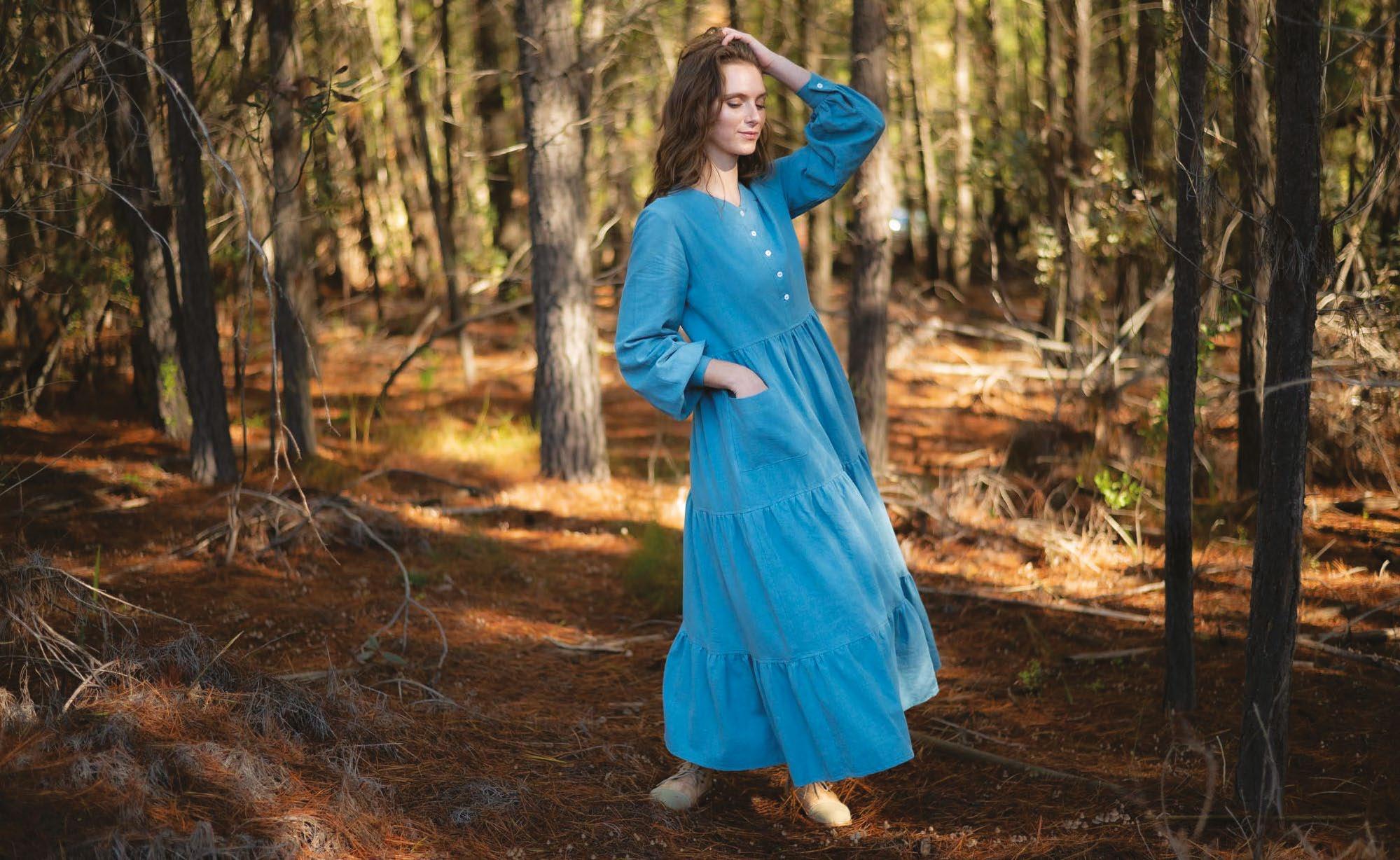
Sage & Sunday epitomises ethical and eco-friendly fashion, crafting collections from hemp linen and cork leather. They champion sustainability without compromising style, advocating for local industries and artisans. Their ethos merges design with dignity, offering minimalist, durable pieces that stand the test of time. Beyond materials, their commitment extends to innovative processes, ensuring every step aligns with their vision for a responsible future. Sage & Sunday isn’t just a brand, it’s a movement towards conscious consumption and a fashion industry that values both elegance and sustainability.






Founded in 2009, Sitting Pretty blends ethnic, masculine, and sportswear styles with a touch of rock ‘n roll and romance. Their collections exude understated chic with a twist, emphasising comfort and confidence. Committed to ethical and slow fashion, Sitting Pretty prioritises longevity and minimising waste in their production line,

Denim has always been more than just fabric. It has seamlessly woven itself into the fabric of fashion history, transforming from a practical utility fabric to a global style icon.
The origin of denim goes way back to the 18th century, when a fabric called ‘serge de Nîmes’ was created in Nîmes, France. In the 19th century Levi Strauss transformed this sturdy material into riveted jeans for miners and labourers, and this is when denim became a symbol of hard work, resilience, and the pioneering spirit.
The mid-20th century found denim at the heart of counterculture movements, from the rebellious stance of James Dean, to the anti-establishment ethos of the 1960s and 1970s hippie movement, when jeans decorated with patches, embroidery, and tie-dye became emblematic of a free-spirited, non-conformist attitude.
Once denim caught the eye of fashion designers, and was integrated into high-end fashion by icons like Calvin Klein and Gloria Vanderbilt, jeans were elevated from casual wear to a fashion statement, and became a fixture in the fashion world.
In an era where sustainability is paramount, denim’s eco-friendly evolution has ensured that it remains not only fashionable but also environmentally responsible, with innovative techniques like organic cotton farming, waterless dyeing processes, and recycled denim all transforming the industry.

Denim is a beacon of authenticity and a symbol of confidence and ease
This iconic fabric’s enduring appeal lies in its ability to evolve without losing its essence. It has effortlessly transitioned from the rugged workwear of the past to the chic, tailored designs of the present, and is inclusive of all ages, genders, and cultures, across the globe.
Denim embodies authenticity, in a world saturated with fleeting trends. It’s all about embracing a classic, enduring style, rather than following the latest fad. Denim clothing items are symbols of a lifestyle that reflects ease and confidence, and the remarkable ability of this versatile fabric to adapt to changing times, embrace new trends, and align with sustainability, makes it a classic and enduring fashion favourite.
As long as fashion continues to evolve and embrace authenticity, denim will continue to remain an integral part of our attire and timelessly relevant in the world of fashion.


RINGS TAKE CENTRE STAGE IN THE VIBRANT LANDSCAPE OF 2024 JEWELLERY TRENDS

Silver jewellery is back in vogue, with statement rings stealing the spotlight. These pieces command attention with their sleek lines and striking presence.


In 2024, consumer demand for ethical and eco-friendly jewellery is on the rise, with a focus on premium recycled materials and ethical sourcing. Lab-grown diamonds are gaining popularity as sustainable alternatives to traditional mined diamonds, reflecting a growing commitment to environmentally-conscious choices.


Classic styles are making a comeback, gracing hands with their timeless elegance, whether adorned with a sprinkle of diamonds, or a more minimalist design featuring a single opulent diamond or another type of gemstone.

From rich blues to vibrant greens, a kaleidoscope of colourful gemstone
is bringing a burst of colour to the scene.

Gold rings are making an opulent statement of their own this year. These lavish adornments exude sheer luxury, a bold presence and rich allure.
The ring always believes that the finger lives for it .

H.G. WELLS

EXPLORATIONS, CONVERSATIONS, AND SOURCES OF INSPIRATION THROUGH REVIEWS OF THE LATEST RELEASES AND TIMELESS CLASSICS
It was in 1990, when J.K. Rowling relocated to Portugal to teach English as a foreign language, that the seeds of the Harry Potter series began to germinate. Despite her life taking a challenging turn with the loss of her mother to multiple sclerosis and the end of her marriage, and despite facing numerous rejections from publishers, Rowling persevered in her writing efforts, completing the first Harry Potter novel in 1995. Finally, in 1997, Bloomsbury Publishing acquired the rights to the book, igniting a literary phenomenon that would captivate audiences worldwide. The Harry Potter series has sold millions of copies globally, inspired a blockbuster film franchise and made J.K. Rowling a billionaire.
An extraordinary journey taken with renowned naturalist and broadcaster, David Attenborough, through the vast tapestry of life that inhabits our planet.
With his signature blend of expertise, enthusiasm, and storytelling prowess, Attenborough unveils the wonders of the natural world in a manner that is both enlightening and awe-inspiring. Told through an examination of animal and plant life, this is an astonishing celebration of the evolution of life on Earth, with a cast of characters drawn from the whole range of organisms that have ever lived on this planet.

One of the most iconic moments in television history was David Attenborough’s meeting with gorillas, which resonated with millions of viewers worldwide. This encounter, and countless other captivating experiences, laid the foundation for Life on Earth.
This timeless work, originally a ground-breaking TV series, reshaped our understanding of nature, setting a new standard of quality and inspiring generations of nature enthusiasts.
Attenborough’s ability to tell stories shines as he delves into the remarkable adaptations and struggles for survival across species. Each chapter showcases the rich diversity of life forms, the ingenuity of nature, and the remarkable adaptations that enable species to thrive in their respective environments – whether recounting the epic journey of migratory birds, the delicate dance of pollination, or the fierce struggles for survival in the animal kingdom.
To celebrate the 40th anniversary of the book’s first publication, David Attenborough revisited Life on Earth, completely updating and adding to the original text, taking account of modern scientific discoveries from around the globe.
This updated edition, which includes more than 60 full-color photographs chosen by the author, provides a fitting tribute to an enduring wildlife classic. It not only enthralled the generation who read it when first published, but Life on Earth will also inspire and stimulate a new generation of readers.
Beyond its captivating narrative, the book serves as a poignant call to action for conservation. Attenborough’s passion for wildlife preservation resonates throughout, urging readers to protect our planet’s fragile ecosystems for future generations.
Life on Earth is a masterpiece that inspires awe and appreciation for the natural world. Attenborough’s unparalleled expertise and advocacy make it essential reading for anyone seeking to understand and safeguard our planet’s majesty.

CHOCOLATE MAKING IS AN ARTISANAL CRAFT THAT TRANSCENDS MERE CONFECTIONERY

In the realm of culinary delights, few treats command as much reverence and adoration as chocolate. Its rich history, health benefits, and ever-evolving culinary applications continue to captivate palates around the globe. But there is a world of craftsmanship, tradition, and personal connection that redefine the very essence of the chocolate industry, far beyond the delectable taste.
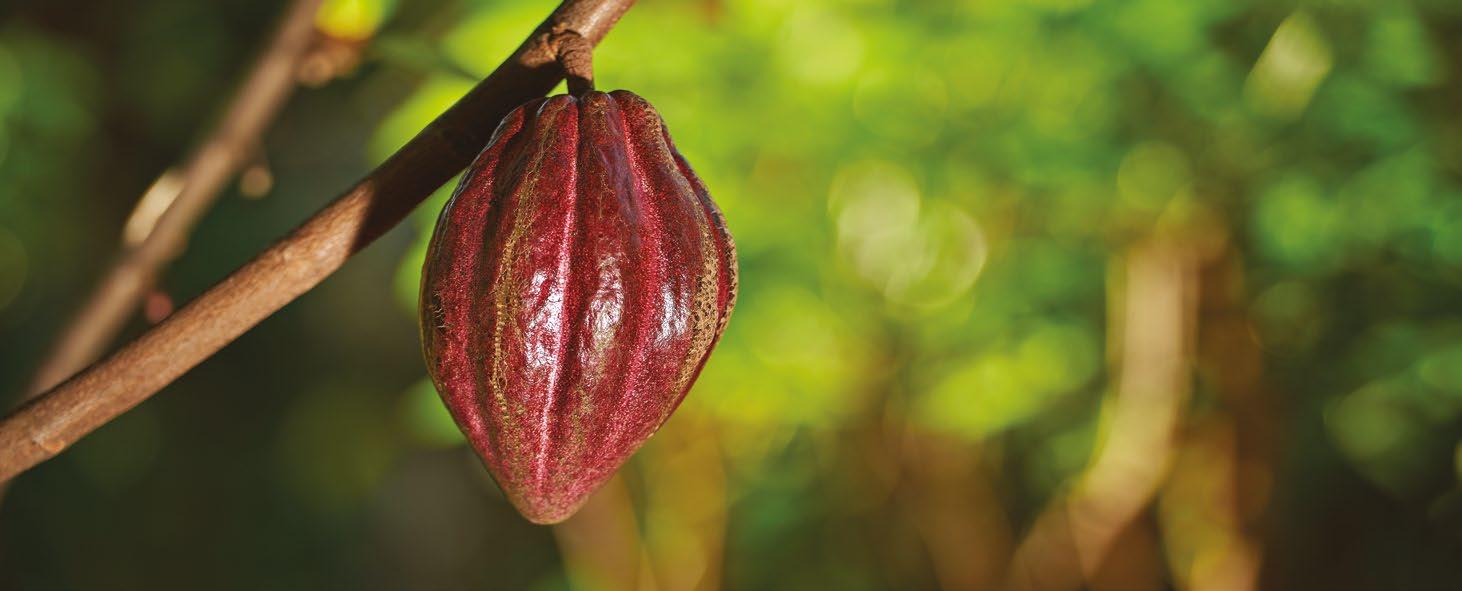
The story of chocolate begins centuries ago in the tropical regions of Central and South America, where ancient civilisations like the Mayans and Aztecs revered the cacao bean as a divine gift. Used for rituals, ceremonies, and currency, cacao held a sacred place in their culture. It wasn’t until the arrival of European explorers that chocolate made its way to the rest of the world, eventually becoming the beloved indulgence we know today.
Modern science has shed light on the numerous health benefits of chocolate, particularly its raw form. Rich in antioxidants, minerals, and moodenhancing compounds, raw chocolate made from minimally processed cacao, offers a guiltfree indulgence for health-conscious consumers. Its complex flavour profile – ranging from fruity to nutty – adds depth to both sweet and savoury dishes, and has revolutionised cooking and baking.
At the heart of the chocolate industry are master chocolatiers who blend artisanal craftsmanship with premium natural ingredients to create edible art. Drawing inspiration from Swiss heritage, these artisans meticulously select unique ingredients, from Italian olive oils to French sea salt, to elevate the flavour of their creations. This hands-on approach ensures that every chocolate is a unique work of art, reflecting the skill and dedication of the artisan.
Similar to wine or coffee, chocolate is infused with the distinct flavour profiles of the climate and terroir – the specific environmental conditions in which the cacao beans are grown. Artisan chocolatiers embrace this diversity by sourcing cacao beans from different regions of the world, each imparting its own unique flavours and
aromas. From the fruity notes of beans grown in Madagascar to the earthy undertones of those from Ecuador, terroir plays a crucial role in shaping the flavour profile of artisanal chocolate.
Tradition meets innovation in the chocolate world, and master chocolatiers delight in pushing the boundaries of flavour combinations. While traditional dark chocolate and milk chocolate remain timeless classics, innovative creations like pink berry chocolate and exotic spice-infused bars captivate adventurous taste buds. Guided by a relentless pursuit of excellence, these artisans strive to please the taste sense with every bite.
Beyond flavour and craftsmanship, the best chocolatiers in the world also prioritise sustainability and ethical sourcing. Partnering with global chocolate manufacturers who uphold rigorous standards of quality and environmental responsibility, these artisans ensure that every cacao bean is sourced ethically and sustainably. By supporting cacao farms with a proven record of social responsibility, they contribute to the longterm viability of the chocolate industry.
But perhaps the most enduring aspect of chocolate is the emotions it conjures up. From childhood memories of indulging in sweet treats to the relationships formed with local chocolatiers, artisanal chocolate is more than just confectionery – it is a journey back to a simpler time of authenticity and tradition. A reminder of the rich history, craftsmanship, and human connections that make it truly special, and a celebration of the master chocolatiers all over the world, who create with passion, dedication and an unwavering commitment to excellence of their craft.










In the vibrant province of KwaZulu-Natal, as the warm embrace of the sun meets the cool serenity of the night, there are wonderful culinary experiences to be discovered.
I realized very early the power of food to evoke memory, to bring people together, to transport you to other places, and I wanted to be a part of that.
JOSÉ ANDRÉS PUERTA


Stepping into Catia’s Cafe is like entering a chic trattoria in the heart of Rome. The interior seamlessly blends contemporary elegance with Italian charm. Soft lighting, elegant wooden furnishings, and carefully curated touches of chic rustic and contemporary design evoke a sense of relaxed sophistication, creativity, and conviviality, inviting patrons to unwind and linger awhile.
As the sun rises, Catia’s comes alive with the aroma of freshly brewed coffee and the promise of a decadent breakfast spread. From classic poached eggs to avocado toast topped with artisanal ingredients, each dish is meticulously crafted with flavours that delight and nourish, in preparation for the day.
Gourmet lunches are prepared from the finest ingredients and tempt discerning palates with their robust flavours and imaginative presentations. Weekly specials also add an element of surprise and excitement to the Catia’s menu repertoire.
Sundays at Catia’s are steeped in tradition, as families and friends gather to partake in the beloved ritual of the succulent Sunday roast accompanied by hearty sides, evoking memories of home-cooked meals and cherished moments shared around the table.
But what truly sets Catia’s apart is the heart and soul poured into every aspect by the owner, Catia Bortolussi, who fills the chic cafe with a genuine sense of familial warmth and hospitality, making guests feel like friends as they walk through the door – whether they choose it as a regular hangout, a welcoming workspace, or a new favourite daytime meal spot.
Catia’s is fast becoming a cherished cornerstone of the Ballito community, and a beacon of authenticity, delectable cuisine, stylish ambience, and heartfelt hospitality. Here, every meal is a memorable experience and a true celebration of la dolce vita. hello@catiascafe.co.za.





CATIA’S OFFERS MORE THAN JUST A CULINARY EXPERIENCE. IT IS A CONTEMPORARY OASIS, WITH GORGEOUS AESTHETICS, AN INVITING AMBIENCE AND MANY CULINARY DELIGHTS CAPTIVATING THE SENSES.





A GASTRONOMIC ADVENTURE THAT CAPTIVATES THE SENSES AND CELEBRATES THE ESSENCE OF LOCAL FLAVOURS, HERITAGE AND SUSTAINABLE PRACTICES.

Set amidst the tranquil ambience of Summerhill Guest Estate, The LivingRoom stands as a beacon of culinary excellence in the heart of KwaZulu-Natal. As one of the country’s premier dining destinations, the restaurant promises an extraordinary gastronomic journey, where each dish is deeply rooted in passion and a profound commitment to quality, sustainability, and the celebration of local flavours.
Chef Johannes Richter, co-owner of The LivingRoom, brings a wealth of culinary experience cultivated through a journey that spans continents. Growing up in the vibrant cultural mosaic of Durban and honing his skills in prestigious Michelin-starred kitchens around the world, Johannes embodies a fusion of global culinary techniques imbued with a deep respect for his South African heritage.
In 2017, Johannes and his wife Johanna, made a decision to establish The LivingRoom, a testament to their shared vision of showcasing KwaZuluNatal’s culinary landscape with unparalleled finesse. Johannes’ culinary journey, shaped by childhood travels across Africa and classical training in Germany, underscores his unwavering commitment to honouring the region’s diverse produce and heritage.

Chef Johannes’ meticulous approach to crafting each dish reflects a deep-seated respect for sustainability, seasonality, and the beauty of nature. Drawing inspiration from ancient traditions, modern innovation, and classical techniques, he curates a hyper-seasonal menu that celebrates the region’s bounty with finesse and creativity.
Each dish that emerges from The LivingRoom’s kitchen is a symphony of flavour and artistry, meticulously prepared using locally sourced ingredients that have been procured from farmers and producers within the community. Johannes’ dedication to sustainability extends beyond the plate, as innovative preservation techniques ensure that nothing goes to waste, allowing for a dynamic menu that evolves harmoniously with the changing seasons.
Complementing these incredible culinary creations is The LivingRoom’s extensive wine programme, curated with precision and passion by Johanna Richter. Featuring a selection of premium South African wines, each bottle is carefully chosen to enhance the dining experience and elevate the flavours of Johannes’ dishes. For those seeking non-alcoholic alternatives, Johanna presents thoughtfully crafted pairings featuring in-house syrups, kombuchas, and juices, ensuring that every guest finds a libation that perfectly complements their meal.
Whether to savour a leisurely meal or embark on a culinary journey, The LivingRoom is where discerning diners go to experience culinary excellence, and where passion, provenance, and perfection converge.
The LivingRoom is open for dinner Tuesday through Friday, and for lunch and dinner on Saturdays. info@summerhillkzn.com.







LEADING GOLF ESTATES AND CLUBS WORLDWIDE ARE CHALLENGING TRADITIONAL NOTIONS OF SUSTAINABILITY AND CONSERVATION TO ENSURE A FUTURE OF HARMONIOUS COEXISTENCE

Residential golf estates and golf courses have always stood as bastions of leisure, luxury, and natural beauty. However, behind the immaculate fairways and serene landscapes lies a complex environmental story that has garnered both criticism and admiration. Traditionally associated with heavy water consumption, chemical usage, and habitat destruction, golf courses have faced scrutiny for their ecological footprint. Yet, amidst this controversy, a new narrative is emerging – one of environmental stewardship, biodiversity conservation, and sustainable innovation. And Zimbali Estate is an important chapter in this story.
Renowned as a premier lifestyle destination and a top golfing destination worldwide, Zimbali Estate transcends the traditional image of a golf course. Rated as the number one golf course in KwaZulu-Natal and acclaimed as one of the top eco estates globally, Zimbali Estate’s commitment to environmental preservation is evident in every aspect of its golf course management. Here, the golf course is more than just a sporting venue. It is the heart of a thriving community committed to sustainability, and it is managed by dedicated environmental stewards. But Zimbali Estate’s commitment to sustainability extends far beyond its championship golf course; it’s a philosophy deeply ingrained in every aspect of its operations.
One of the most remarkable achievements of Zimbali Estate lies in the restoration of critical habitats surrounding the golf course. Coastal forest and grassland areas have been restored from what was originally sugar cane and gum plantations, resulting in a net gain for biodiversity. Through thoughtful management practices, wetlands have been protected, and they provide refuge for endangered species like the Pickersgill’s Reed Frog.
Water, a finite and precious resource, is managed with precision and care at Zimbali Estate. By embracing innovative practices such as utilising recycled greywater and strategic abstraction from local water sources, the golf course minimises its water footprint while nourishing surrounding ecosystems. This holistic approach ensures that water sustains the lush greens as well as vital habitats, filtering through wetlands and replenishing groundwater sources.
Far from being just a golfer’s paradise, the Zimbali Estate golf course serves as a sanctuary for a diverse variety of flora and fauna. From elusive antelope species like the Natal Red Duiker to the industrious porcupine, wildlife thrives here in harmony with the golfing community. Through initiatives like its grassland restoration and wetland rehabilitation, Zimbali Estate has crafted a unique ecosystem where biodiversity flourishes alongside recreational pursuits.
Sustainability is an ingrained philosophy


Like Zimbali Estate, golf courses worldwide are embracing eco-friendly practices to ensure a greener future for the sport and the planet. From the historic St. Andrews Links in Scotland to the organic marvel of Vineyard Golf Club in Martha’s Vineyard, these premier destinations showcase the transformative power of sustainable golf course management.
Renowned for its rich golfing history, St. Andrews Links stands as a beacon of sustainable practices in golf course management. Through initiatives like sand dune restoration, wildlife conservation, and renewable energy adoption, St. Andrews sets a gold standard for environmental stewardship in the golfing world.
In Australia, Kabi Golf Course takes a unique approach to sustainability by embracing the natural landscape and fostering native wildlife. By eschewing traditional manicured fairways and adopting a ‘play the ball as it lies’ policy, Kabi Golf Course offers a refreshing perspective on environmentally friendly golfing experiences.

The Vineyard Golf Club exemplifies a commitment to organic turf care that sets it apart. Through collaboration with experts and a dedication to innovation, the Vineyard Golf Club has established itself as a global leader in organic golf course management, proving that luxury and sustainability can go hand in hand. Fascinatingly, the club administers organic pesticides on its greens and conducts a distinctive morning ritual of fairway whipping, eradicating excess moisture and deterring fungal proliferation.
Jumeirah Golf Estates in Dubai has been rooted in environmental stewardship from its inception, and sets a new standard for golf course sustainability in the Middle East and beyond, blending luxury living with ecological responsibility. An extensive tree planting programme was undertaken, and innovative practices such as using recycled water for irrigation, implementing state-of-the-art turf management techniques, driving zero-emission golf carts, and preserving native flora and fauna, exemplify Jumeirah Golf Estates’ commitment to sustainable golf course management.
The future of golf lies in sustainability, and many inspiring stories are unfolding on green courses around the globe. Prioritising environmental stewardship, embracing innovation, and fostering collaboration, can pave the way to a future where golf and conservation coexist in perfect harmony. As golf continues to evolve, the golf industry must continue to embrace environmentally friendly golf practices to ensure that green golf courses offer a blueprint for a more sustainable future, which has an impact far beyond golf.
A future where golf and conservation coexist in perfect harmony


THE EVOLVING TREND OF CARVING OUT PERSONALISED SANCTUARIES WITHIN OUR HOMES IS VITAL TO OUR OVERALL WELLBEING

In the fast-paced rhythm of contemporary life, the quest for solace and wellbeing has emerged as a fundamental pursuit. Our approach to living spaces has undergone a noticeable transformation, emphasising the imperative of claiming space – not merely physical, but also mental and emotional – to nurture our overall health.
Within the realm of interior design, a discernible trend has taken root: the creation of sanctuaries within our homes. No longer solely dictated by aesthetics, the arrangement of our living spaces now prioritises emotional resonance. This year, design trends are reflecting this evolution, signalling a movement towards interiors crafted to serve as havens, instilling feelings of safety, security, and emotional fulfilment.
These sanctuaries are meticulously curated to influence behaviour and evoke deep emotional responses. They transcend mere decor, acting as self-soothing spaces that elevate our spirits and foster a profound sense of calm and happiness. By enveloping ourselves in environments that are tailored to our emotional needs, we enrich our overall wellbeing.



Critical to this enrichment is the inclusion of designated creative spaces within our homes. Whether it’s a cosy writing nook, a captivating library corner for getting lost in alternate realms, a fireside spot for knitting winter scarves, a compact studio for painting endeavours, or a craft table tucked in a corner, these areas serve as vital outlets for expression and rejuvenation. Engaging in creative pursuits not only allows us to explore our passions but also provides a sense of fulfilment and accomplishment, contributing to our mental and emotional wellbeing.
The significance of carving out sanctuary spaces within our homes cannot be overstated, particularly in the context of mental health. In an era where stress and anxiety abound, having a designated refuge offers a vital escape from the pressures of daily life. Stepping into these sanctuaries, adorned with elements that resonate with our souls, allows us to find solace, recharge our energies, and confront challenges with renewed vigour.
However, claiming space can also extend beyond the confines of our homes. Sometimes, the sanctuary we seek lies in the embrace of nature’s tranquility. Whether it’s a serene forest, a
secluded beach, or a majestic mountain peak, communing with the natural world offers a profound sense of peace and connection.
Weekend retreats away also offer a reprieve from the hustle and bustle of daily life, allowing individuals to reclaim their own space, and recharge and reconnect with themselves in new and refreshing surroundings.
In essence, the concept of claiming space transcends mere physical dimensions; it encompasses a profound understanding of our holistic wellbeing. By crafting havens within our homes, communing with nature, and taking time for weekends away, we embark on a journey towards self-discovery and fulfilment. In doing so, we honour the ancient wisdom that recognises the destructive nature of life’s many stresses, and the transformative power of claiming space in all its myriad forms.
A creative refuge contributes to wellbeing



THE PAST IS CHERISHED AND REIMAGINED WITHIN THE VIBRANT TAPESTRY OF THE PRESENT IN THIS VISUALLY STUNNING ZIMBALI ESTATE HOME

Overlooking a panoramic vista of rolling golf course fairways, lush forest, and the glistening sea beyond, within the breathtaking Zimbali Estate, is a home that epitomises the very essence of eclectic elegance. From the moment you walk up the exterior wooden staircase and into the inner sanctum of this architecturally beautiful abode, you are immediately embraced by an ambience that seamlessly integrates the beauty of the outdoors with the comfort of indoor living.
The living room and bar area are airy and light, with indoor plants cascading from pots and macramé plant hangers, punctuating the space with vibrant greenery that contrasts elegantly with white furniture and accent pieces.
The design ethos of this residence is a captivating fusion of raw elements and refined aesthetics. From the warm allure of wooden beam ceilings to the openness that allows the gentle breeze to meander through, every aspect of this home exudes a sense of harmony with its natural surroundings.





IN THE REALM OF CREATIVITY, ECLECTICISM IS THE ALCHEMY THAT TRANSFORMS DISPARATE INSPIRATIONS INTO A UNIFIED MASTERPIECE.
ANONYMOUS

Throughout the home, there is a captivating blend of contemporary styling and vintage charm. Animal print fabrics live alongside geometric black and white patterns, handcrafted elements and embroidered pillowcases add touches of panache to comfortable sofas, while strong punches of colour ground the rooms, infusing them with character and depth. Yet, amidst the mix of styles and textures, there is a sense of cohesion that speaks to the owners’ discerning taste and unwavering love for art and design.
Nowhere is this more evident than in the main bedroom, a sanctuary of beauty and comfort where every element has been thoughtfully curated to create a space that is both calming and inviting, with the bathroom carrying the indooroutdoor theme into a naturally serene exterior shower area.

The contrast of both wood and slate floors in different rooms, sets the tone of the entire interior as warm and welcoming, as well as stylish and sophisticated.



This captivating home is truly a testament to the power of personal expression in interior design. By embracing elements that resonate with their unique personality and passion, the owners have created a space that is not only visually stunning but also deeply resonant. This exquisite abode is also a reminder that eclectically elegant design is not just a modern trend but a timeless expression of individuality and creativity.




THE LATEST NEWS AND TRENDS IN HEALTH AND WELLNESS
The Global Wellness Summit recently unveiled the ‘10 Wellness Trends for 2024’ and it marked a pivotal moment in the ever-evolving landscape of health and wellbeing.
With a keen eye on emerging societal shifts and technological advancements, these trends illuminate the path towards holistic wellness in the digital age.
From the rise of biohacking technologies to cold destination travel, to the integration of mental health in workplace culture, each trend embodies a commitment to fostering balance and resilience in an increasingly interconnected world.
As we navigate the complexities of modern living, these trends serve as guiding principles, empowering individuals and communities to embrace a more mindful and purpose-driven approach to modern wellness.



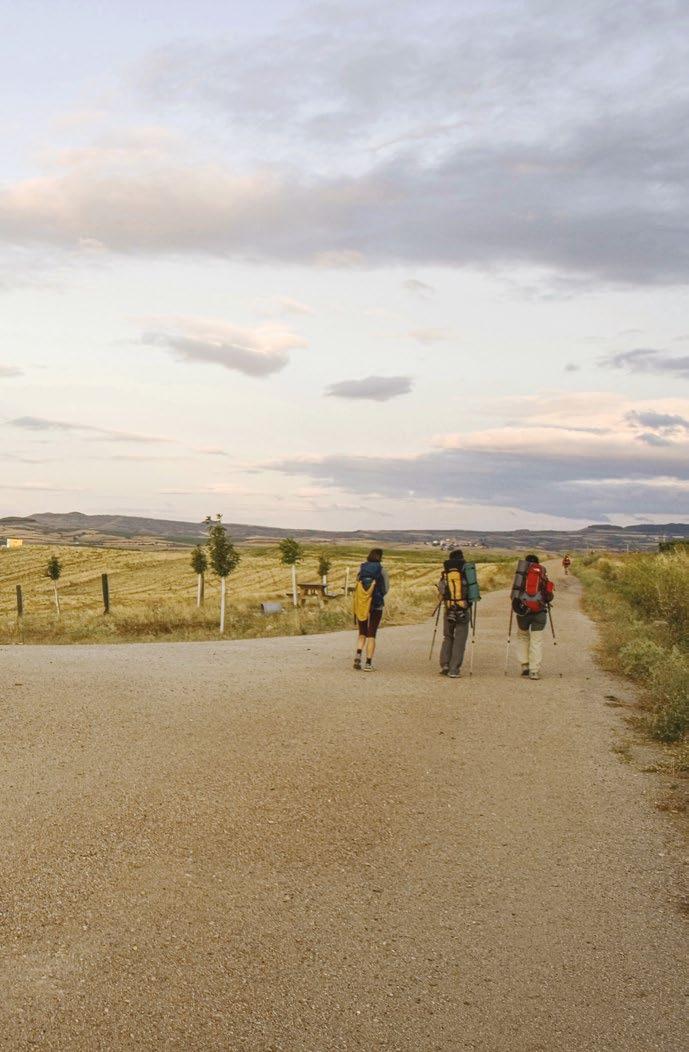
The trend of health-at-home is rapidly gaining momentum, driven by innovations like medical-grade monitoring systems and versatile furnishings. Following the pandemic, as people continue to spend more time at home, there’s been a noticeable shift towards viewing the home as a sophisticated health hub. This evolution is reshaping the landscape of wellness real estate, with homes becoming equipped with cutting-edge technologies aimed at enhancing personal wellbeing. From homespas to advanced monitoring devices, and adaptable furniture designed to promote physical activity and ergonomic comfort, the home is emerging as a central pillar in fostering holistic wellness in the digital age.
The past few years have highlighted the importance of nature as a source of personal healing and rejuvenation. This shift has led to a wellness-focussed approach to travel, with enthusiasts worldwide embarking on pilgrimage trails to reconnect with the natural world and engage in spiritual exploration. Responding to this growing interest, hotels and wellness retreats now offer tailored programmes that include personalised nutrition, bespoke exercise plans, individual coaching sessions, and holistic healing therapies, providing travellers with comprehensive experiences that nurture mind, body, and spirit.
Amidst the pressing threat of global warming, the imperative to incorporate climate-conscious practices into wellness initiatives has never been more urgent. Innovators are prioritising climateadaptive wellness solutions, leveraging technologies like green spaces and advanced building materials to counteract rising temperatures. As the planet warms, travel shifts from conventional ‘hotspots’ to cooler destinations, like Scandinavia. This transition, known as ‘coolcations’, reshapes traditional wellness with a focus on hot and cold therapy, and ‘night-time wellness’ programmes, while activities like star-gazing and full-moon yoga offer guests immersive experiences in cooler temperatures.
The burgeoning longevity sector is undergoing a transformative evolution, driven by unprecedented advancements in biotechnology, healthcare, and wellness. With an ageing population prioritising extended health spans, and healthcare systems still lagging in preventive measures, longevity is set to significantly expand in 2024. Once merely havens for relaxation and rejuvenation, wellness resorts are now emerging as hubs of cuttingedge medical and longevity services. These facilities now offer an array of advanced therapies, personalised healthcare regimens, and preventive interventions aimed at enhancing longevity.
The landscape of fitness has evolved significantly, transitioning from solitary gym workouts to communal and empowering sports activities. There’s a growing trend among individuals to aspire to train like near-elite athletes, prompting upscale wellness resorts to meet this demand by offering exclusive training sessions with renowned sports figures. This shift has sparked a surge in sports tourism, with destinations refocussing their attention from passive spectators to active participants, inviting travellers to fully engage in the excitement of athletic endeavours.



A SANCTUARY WHERE MODERN LUXURY AND THE UNTAMED SPIRIT OF AFRICA CONVERGE


In the realm of wellness trends for 2024, where sustainability, conservation, and a return to nature converge, Thuleni Homestead in Manyoni Game Reserve stands as the quintessential destination, not only for individuals seeking rejuvenation but also for families yearning to reconnect amidst the splendour of the African bushveld. Against the backdrop of luxury accommodation intertwined with nature, Thuleni offers an ideal sanctuary to carve out space and immerse yourself in the rhythms of nature, and it is the perfect place to find a unique safari experience.
It takes just three-hours from King Shaka Airport to be greeted by Manyoni Game Reserve’s sprawling Acacia bushveld spanning 23,000 hectares, and a welcoming smile from the guard at the Eastern Gate. A leisurely self-drive from the entrance gate to the homestead becomes an exhilarating game drive, with sightings of captivating wildlife along the way, before you arrive at Thuleni to find a tranquil, beautifully styled home-from-home waiting for you.
From the moment you enter the carved African doors, you feel that this is a haven, merging modern luxury with the untamed allure of the African bush. Designed by acclaimed architect Richard Stretton, the design ethos of ‘touch-theearth-lightly’ is evident in every detail, reflecting a calm coexistence with the natural surroundings, and creating an atmosphere of harmony and immersion in the bushveld. The lines between indoors and outdoors blur seamlessly, and floorto-ceiling glass panels provide panoramic views of the pool deck and busy waterhole below, and allow streams of soft sunlight to enter each morning.
In every room, Thuleni Homestead exudes earthy elegance, encapsulating a rustic chic aesthetic. Here, luxury meets sustainability, as elements drawn from the earth infuse the space with both opulence and authenticity. From the stone walls to the upcycled Tamboti pillars, the homestead reflects a deep respect for the environment and a commitment to mindful living.
Wandering through the interior, you find a harmonious blend of natural materials, including reclaimed wood and stone, that complement the earth tones and create a warm and inviting ambience. Decor accents pay homage to the surrounding wild landscape while adding a touch of raw, organic beauty. Walls showcase interesting artwork by local South African artists, further enhancing the homestead’s unique charm. And as you stop in the expansive open-plan living area for a moment and contemplate your surroundings, elegance and sustainability coalesce in this luxurious sanctuary.




Only game viewing will entice you to leave the peaceful calm of Thuleni, once you’re settled in, and embarking on an early morning drive with ranger Sandiso through the African bush, feels like an exhilarating journey into the heart of the untamed unknown. His wonderful stories, and expertise and passion for wildlife, bring game drives to life. Every turn holds the possibility of encountering Africa’s majestic Big Five in Manyoni Game Reserve, graceful impalas graze amongst herds of wildebeest and zebras, as a giraffe ambles through the grass close by. Over 455 bird species flit through the trees and across the skies, in addition to the abundance of wildlife that wander across a scenic tapestry of riverine woodlands, savannahs, and hilly terrain.
And as the setting sun bathes the landscape in golden hues, and the vehicle turns for home, the air comes alive with the sounds and scents of the wild, creating an immersive experience that awakens your senses and leaves an indelible imprint on your soul.



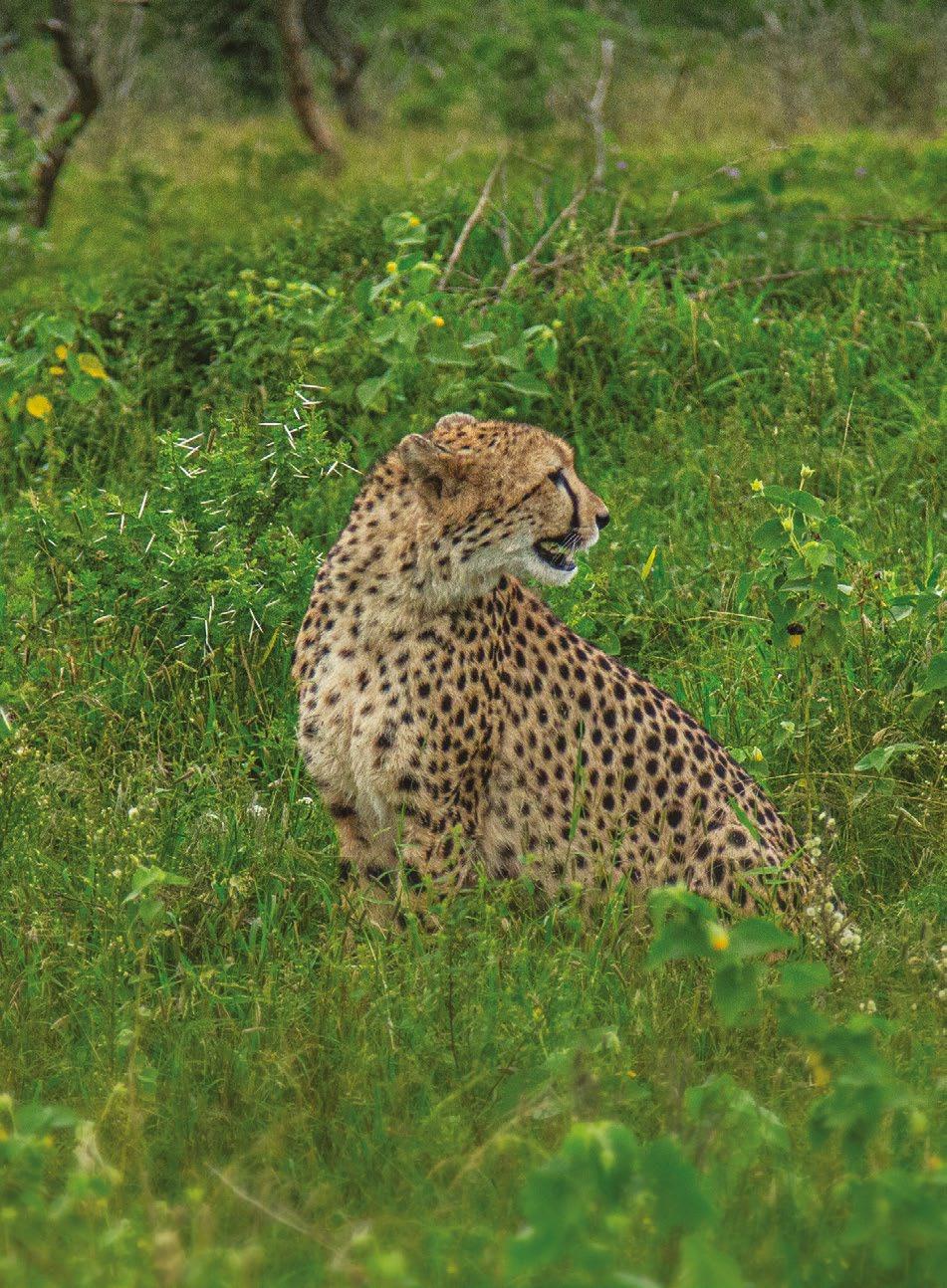

Returning to Thuleni after a few hours of adventure feels like coming back to a refuge of tranquility. The fires are lit as leisurely dinner preparations get underway, and the aromas mingle with the earthy bush scent. Gathered around the crackling flames in the boma, with the distant call of a hyena echoing in the night, there is a profound sense of connection to the wilderness all around that lingers, until you finally sink into the plush comfort of a luxurious bed in one of five beautifully appointed bedrooms, enveloped in the stillness of the night.


Even just a few days at Thuleni Homestead offers a perfect balance of time – enough to exhale, rekindle connections, and allow your soul to find sanctuary in the untouched beauty of the African bushveld. And when you leave, it is with cherished memories and a heart infused with the enchantment of the wild, a testament to the transformative journey that took place in this peaceful haven.









In our fast-paced world, the quest for tranquility has never been more urgent. Amidst the cacophony of modern life, the ancient practice of shinrin-yoku, or forest bathing, offers a sanctuary for our weary souls. Originating in Japan in the 1980s, this practice has garnered global attention as a potent antidote to stress and anxiety.

UNCOVER THE SCIENCE AND TRANSFORMATIVE HEALTH BENEFITS OF SHINRIN-YOKU
Shinrin-yoku isn’t merely a whimsical stroll through the woods, it’s a scientifically backed therapy that harnesses the healing power of nature. Numerous studies have shown that spending time in green spaces can reduce cortisol levels, lower blood pressure, and improve overall wellbeing. The secret lies in the air we breathe: forests release phytoncides, airborne chemicals with antimicrobial properties that have a calming effect on the human body.
The benefits of forest bathing extend far beyond relaxation. Studies suggest that regular practice can boost immune function and reduce the risk of infection. Forest bathing also enhances cognitive performance, sharpening our mental acuity and enhancing our ability to focus and solve problems. Shinrin-yoku fosters a profound sense of awe and gratitude towards the natural world, as surrounded by the majesty of towering trees, we are reminded of the interconnectedness of all living beings.
The restorative effects of nature on the mind have also been shown to stimulate creativity and innovation, unlocking new pathways of thought and inspiration, as well as improve sleep quality. The holistic rewards of shinrin-yoku are as diverse as the flora and fauna that inhabit the forest.
In our hyperconnected world, the notion of unplugging may seem daunting. Yet, shinrinyoku invites us to step away from our screens and immerse ourselves in the natural world. Even just a two-hour forest bath can work wonders, allowing us to slow down, quiet our minds, and reconnect with ourselves and the environment.

Residents and visitors wander along Zimbali Estate’s coastal forest trails and find the healing embrace of nature, surrounded by the harmonious symphony of birdsong, and an abundance of wildlife.

From ancient woodlands to lush rainforests, forest bathing destinations span the globe. Countless retreats and guided walks offer opportunities for individuals to embark on their own journey of selfdiscovery, including the towering redwoods of California, the mist-shrouded forests of Japan, the Hallerbos ‘Blue Forest’ in Belgium, the Amazon Rainforest, and the verdant forests of KwaZulu-Natal. With their untamed beauty and tranquil serenity, these green oases are perfect shinrin-yoku destinations waiting to be discovered.


IN A WORLD PLAGUED BY STRESS AND UNCERTAINTY, SHINRIN-YOKU OFFERS A BEACON OF HOPE AND RENEWAL. BY IMMERSING OURSELVES IN THE RESTORATIVE EMBRACE OF THE FOREST, WE CAN REDISCOVER THE SIMPLE JOYS OF LIFE AND EMERGE REJUVENATED. THE FOREST IS CALLING – AND IT’S TIME TO ANSWER.

Redwood forests bring relaxation and rejuvenation, but also cultivate resilience, clarity of mind, and a deep-seated appreciation for the beauty and interconnectedness of the natural world.
Trees are poems that the earth writes upon the sky

KAHLIL GIBRAN

THE INTRIGUING TALE OF AN ANCIENT ENIGMA
In the hushed corridors of historical enigma, few artefacts stir as much curiosity and fascination as the Voynich Manuscript. Often termed ‘the world’s most mysterious manuscript’, its pages are adorned with intricate illustrations of unknown plants, peculiar celestial diagrammes, and cryptic script that has baffled linguists, historians, and cryptographers for centuries. Yet, within its enigmatic folds, lies not just a puzzle but a testament to the enduring allure of the unknown and the relentless pursuit of knowledge.
The origins of the Voynich Manuscript remain shrouded in uncertainty, adding to its mystique. Discovered by Wilfrid Voynich, a rare book dealer who acquired it in 1912, its exact date of creation and authorship have always remained elusive. Carbon dating places its creation around the early 15th century, during the Italian Renaissance, yet the circumstances of its creation and the identity of its author remain a tantalising mystery.
At the heart of the Voynich Manuscript’s enigma lies its indecipherable script, a language that has defied all attempts at translation. Scholars have pored over its pages, applying various linguistic and cryptographic techniques in a bid to unlock its secrets. Yet, after centuries of effort, the manuscript’s script remains stubbornly inscrutable, which has led to a plethora of theories ranging from a lost natural language to an elaborate hoax.
The preservation of the Voynich Manuscript has been a subject of great importance, given its historical significance and delicate condition. Today, the manuscript is safeguarded within the confines


of prestigious institutions such as Yale University’s Beinecke Rare Book & Manuscript Library. Under controlled conditions, it continues to captivate both scholars and enthusiasts, serving as a focal point for research and much speculation.
Theories regarding its origin and purpose vary dramatically, with some suggesting it to be a herbal or pharmacological text, while others propose it to be an elaborate cipher or a work of arcane knowledge. Recent advancements in artificial intelligence and machine learning have led to renewed efforts in deciphering the manuscript, offering a glimmer of hope in unravelling its secrets. But to date. not even AI has been able to crack the Voynich code.



In an age defined by instant access to information and rapid technological advancement, the Voynich Manuscript stands as a testament to the enduring allure of the unknown. Its cryptic script and enigmatic illustrations serve as a reminder that irrespective of how far we have come, technologically, there are still boundless mysteries that continue to evade human understanding.





The pages of this ancient tome that continue to defy comprehension, with its unknown script and intricate illustrations, have created a world of intrigue and speculation. A world where the boundaries between history and legend blur, and the quest for knowledge transcends time itself. Perhaps the true beauty of the Voynich Manuscript lies not in its decipherability, but in what it inspires - curiosity, imagination, and the unwavering belief that some mysteries just have to be explored, even if they do remain forever beyond our grasp.

MACRO IMAGES REVEAL A NEW DIMENSION OF LIFE
PHOTOGRAPHY EGOR KAMELEV









Founded in 1921
With over 100 years of experience, Kearsney offers an ideal boarding environment for boys.
Weekly buses from Ballito, Umhlanga, Zululand and Pietermaritzburg for returning boarders. Be a part of one of SA’s leading independent traditional boys’ schools.

Apply now for Grade 8 2026 and beyond.
Enquiries: marketing@kearsney.com or 031 765 9600

THE REVOLUTION OF HEALTHCARE WITH AI AND ROBOTICS
WORDS CATE STEVENSON
In the ever-evolving landscape of healthcare, technology is constantly pushing the boundaries of what’s possible, driving hope in relation to patient outcomes, and reshaping the healthcare industry in ways previously unimaginable.
From personalised treatments to predictive diagnostics, new medical innovations are transforming the way we approach wellness and revolutionising patient care. Robotics and artificial intelligence (AI) have become gamechangers among the most ground-breaking innovations, and their integration in medicine have ushered in a new era of precision, efficiency, and safety.
In the pivotal area of diagnostics, AI can analyse vast amounts of medical data, including imaging scans, genetic information, and patient records, to identify patterns, and make predictions with unprecedented accuracy. AI-driven systems meticulously scrutinise medical imagery like X-rays, MRIs, and CT scans, and detect subtle abnormalities and patterns that might escape the human eye. This capability is revolutionising radiology and proving invaluable in early disease detection and personalised treatment planning, ultimately leading to better outcomes for patients.


One of the most revolutionary advancements in medicine has been the integration of robotic systems into surgical procedures. These systems, which are often controlled by skilled surgeons, offer unparalleled dexterity, enabling complex operations with minimal invasiveness. Roboticassisted surgery has transformed various procedures in specialties such as urology, gynaecology, and cardiothoracic surgery.
As an example, a robotic prostatectomy is a minimally invasive procedure for treating prostate cancer. By utilising robotic systems, surgeons can navigate with enhanced precision, reducing the risk of complications and accelerating recovery times for patients. Similarly, in gynaecological surgery, robots have facilitated intricate procedures such as hysterectomies with smaller incisions and decreased postoperative pain.
Moreover, AI algorithms can predict patient outcomes based on individual characteristics, helping physicians tailor treatment plans for optimal efficacy. In oncology, for instance, AI algorithms analyse genetic profiles to identify targeted therapies that are most likely to benefit specific patients, ushering in a new era of precision medicine.

The integration of robotics and AI extends beyond the operating room, with transformative implications for remote patient monitoring and telemedicine. Telehealth platforms equipped with AI algorithms enable patients to access healthcare services remotely, reducing the need for in-person visits and enhancing access to care, particularly in underserved areas.
Robotic devices equipped with sensors can monitor patients’ vital signs in real-time, providing continuous data streams to healthcare providers. These devices can detect early warning signs of deteriorating health and intervene promptly, preventing complications and reducing hospital readmissions. AIdriven chatbots and virtual assistants are also revolutionising patient communication, providing personalised health advice and support around the clock.
While the integration of robotics and AI holds immense promise for healthcare, it also presents some unique challenges and ethical concerns surrounding data privacy, algorithm bias, and the potential for job displacement, and there have been calls to ensure equitable access and ethical use of these technologies. It is also critical that regulatory frameworks evolve to keep pace with rapid technological advancements, to safeguard patient safety.
The future of healthcare looks brighter and better, as robotics and AI continue to evolve. These transformative technologies have the potential to revolutionise every aspect of healthcare delivery, from diagnosis to treatment and beyond, and by harnessing their power, healthcare providers can achieve greater precision, efficiency, and patient outcomes, ushering in a new era of medicine that is completely and truly transformative.



BIOPHILIC ARCHITECTURE IS REVOLUTIONISING THE WAY WE INHABIT OUR CITIES AND SPACE

In an age where urbanisation is accelerating at an unprecedented pace, and concrete jungles seem to stretch endlessly, a longing for connection with nature is emerging. Biophilic architecture, a design philosophy that seeks to integrate natural elements into the built environment, has become a beacon of hope, offering a harmonious balance between the man-made and the natural world. Biophilic architecture looks to connect people living in buildings more closely to nature and is ushering in a new era of sustainable and wellness-focussed design.
Coined by American biologist Edward O. Wilson in the 1980s, the term ‘biophilia’ refers to the instinctive bond between humans and other living systems. Biophilic architecture seeks to nurture this connection by incorporating natural elements – such as plants, water, sunlight, and natural materials – into the built environment. By blurring the boundaries between indoors and outdoors, biophilic design creates spaces that evoke a sense of tranquillity, vitality, and wellbeing.
In bustling metropolises around the globe, biophilic architecture is reshaping the urban landscape. One iconic example is the Bosco Verticale (Vertical Forest) in Milan, Italy. Completed in 2014, this pair of residential towers is adorned with more than 900 trees, 5 000 shrubs, and 11 000 plants, creating a vibrant urban ecosystem that purifies the air and provides a habitat for birds and insects.




As you step inside a biophilic building, you’ll immediately notice a difference in ambience. Sun-drenched interiors, natural ventilation, and the soothing sound of flowing water create a multisensory experience that appeals to our primal instincts. The Singapore Changi Airport’s Jewel is a prime example of biophilic design on a grand scale. Its centrepiece, the Rain Vortex, is the world’s tallest indoor waterfall, surrounded by lush gardens and natural light, transforming the airport into a tranquil oasis amidst the bustling terminals.
In fact, the entire city-state of Singapore arguably stands as the world’s first ‘biophilic city’. Authorities have undertaken extensive efforts to integrate plants, water, and wildlife into buildings, parks, streetscapes, and government offices.
As we embrace the digital age, technology is playing an increasingly vital role in the realisation of biophilic architecture. From smart sensors and automated climate control systems to virtual reality tools, advanced technology systems can communicate design concepts, optimise resource use, monitor energy consumption, minimise environmental impact, and ensure occupants’ comfort. The Green School in Bali, Indonesia, exemplifies this synergy between technology and nature. This innovative bamboo structure used advanced engineering and architectural tools, along with sustainable materials and renewable energy systems, to create a campus that seamlessly integrates with its natural surroundings, fostering a deep connection to the environment while embracing modern amenities and comforts.



In a world grappling with the urgent challenges of climate change and ecological degradation, biophilic architecture offers a ray of hope. By fostering a deeper connection with the natural world, we not only enhance our quality of life but also cultivate a profound respect for the planet we call home. As we look to the future, we need to embrace the principles of biophilic design as a guiding light towards a more sustainable and resilient built environment, where humans and nature coexist in harmony.
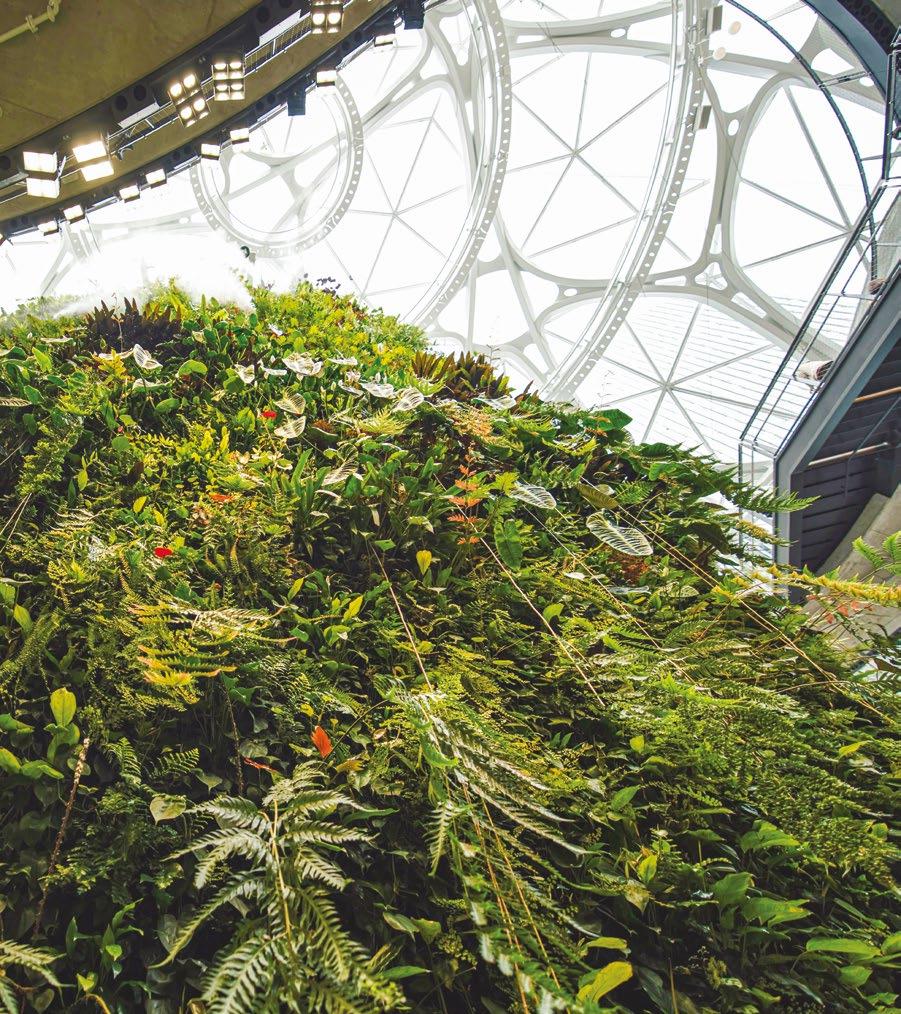

Biophilic architecture represents a paradigm shift in the way we conceive and inhabit our built environment. By reimagining our cities as living ecosystems, we can create spaces that foster a symbiotic relationship between humanity and the natural world. As we journey towards a greener, more sustainable future, nature is our greatest ally in the pursuit of architectural excellence and environmental stewardship.



As the world grappled with the tumult of the global coronavirus pandemic, people sought solace and escape from the uncertainty and upheaval in the silver screen. Unable to leave their homes, they were inspired by the very locales immortalised in the films they were watching, and a captivating trend emerged, breathing life into a new wave of exploration. ‘Set jetting’ offered a novel twist on the traditional notion of jet-setting, weaving together the allure of travel with the magic of cinema.
From the rugged landscapes of Middle-earth to the enchanting fields of Tuscan romance, travellers found themselves drawn to the tangible allure of the backdrops to their favourite films and TV shows.
The proliferation of streaming platforms, an ever-expanding cinematic landscape, and the influence of celebrities, has amplified the allure of set jetting. Social media platforms like Instagram have become virtual travel guides, enticing adventurers to explore iconic film locations first-hand, breathing new life into communities and businesses, and bolstering local economies along the way.
Set jetting embodies cinematic wanderlust, inspiring travellers to immerse themselves in the settings that captivate them on screen. Beyond passive viewing, they crave to traverse these landscapes, turning fiction into reality. Set jetting offers more than just sightseeing; bespoke packages provide immersive experiences mirroring beloved storylines. From official studio tours to themed adventures, travellers can walk in their favourite characters’ footsteps, and for a moment, merge these storylines into their own lives.



These cinematic odysseys take adventurers to iconic destinations like New Zealand, the location for the filming of The Lord of the Rings and The Hobbit, which stands as the pinnacle of set jetting success, having experienced a surge in tourism since filming first graced its shores, over two decades ago. The more recent Amazon Prime series following this franchise has renewed set jetting interest in the region, where fans are able to enter a hobbit’s house and witness the incredible film scenery in Tongariro National Park.


Spectacular Lake Como in Italy is another prime set jetting destination, as it has been a popular choice for quite a few film settings, including the iconic James Bond movie Casino Royale, as well as Ocean’s Twelve and the TV series Succession
Another recent popular set jetting destination in Italy is the pictureseque island of Sicily, the location for The White Lotus, which has fans seeking cinematic adventures in the coastal town of Cefalu and against the stunning hilltop backdrop of Taormina.



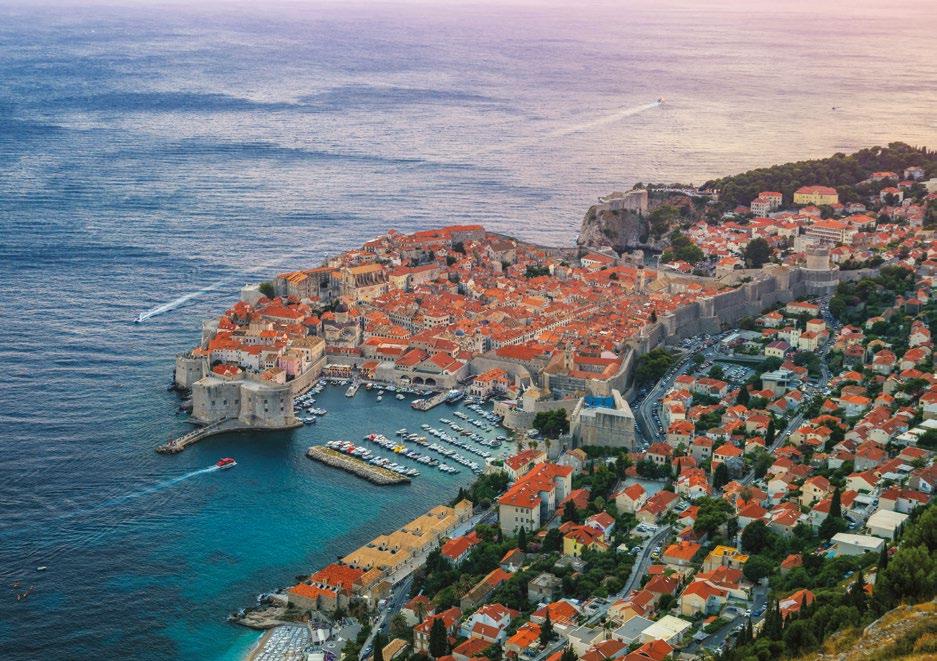
In Dubrovnik, Croatia, Game of Thrones aficionados immerse themselves in the intrigue and splendour of the fictional King’s Landing, as they visit the ancient walls and wander the winding cobblestone streets of the city’s medieval Old Town.



Paris, City of Light, encapsulates the essence of countless iconic films. Visitors have the chance to wander through the real-life backdrops of beloved movies like Amélie or Midnight in Paris, tracing the footsteps of cinematic characters against a setting of architectural splendour and cultural richness. With its blend of history, art, and gastronomy, Paris continues to enchant and inspire, cementing its status as a premier destination for lovers of the silver screen.
The stark and untamed beauty of Svalbard in Norway has served as a striking locale for numerous films, drawing adventure-seeking set jetters. From the icy landscapes of Mission Impossible to the gripping scenes of espionage in Die Another Day, Svalbard offers travellers the chance to lose themselves in the magic of the movies, as tales of exploration, intrigue, espionage and adventure come to life amidst the Arctic wilderness.




Our world is not in your books and maps , It’s out there .
Set jetting promises an adventure different to any other. From the cobblestone streets of Bucharest to the shadowy bridges of London, every journey is a reel-life adventure waiting to unfold. Yet, beyond the allure of picturesque backdrops and immersive experiences, set jetting embodies a deeper connection – a shared journey between storytellers and adventurers. It revitalises communities, fosters cultural exchange, and cultivates a profound appreciation for the power of storytelling to transcend borders and inspire exploration.



















3D PRINTED CORAL IS REVITALISING MARINE BIODIVERSITY

The world’s coral reefs are facing unprecedented threats, with rising sea temperatures and human activities causing widespread degradation. In the race against time to save these vital ecosystems, scientists are turning to innovative technologies for solutions. Among these, 3D printing has emerged as a promising tool for coral reef conservation, offering a new dimension in restoration efforts. By creating artificial coral structures that mimic the complexity of natural reefs, researchers are paving the way for a more resilient future for these invaluable marine habitats.
Coral reefs are often referred to as the ‘rainforests of the sea’ due to their incredible biodiversity and ecological significance. However, they are also among the most threatened ecosystems on the planet. Rising sea temperatures, pollution, overfishing, and destructive fishing practices have led to widespread coral bleaching and habitat loss. The decline of coral reefs not only poses a threat to marine biodiversity but also jeopardises the livelihoods of millions of people who depend on reefs for food, income, and coastal protection.
In the face of these challenges, scientists are exploring innovative approaches to restore and conserve coral reefs. One approach that is gaining rapid traction is 3D printing. Traditionally used for manufacturing objects ranging from human organs to aerospace components, 3D printing technology is now being adapted for coral reef restoration.
The concept is straightforward yet groundbreaking: using biodegradable materials, scientists can create artificial coral structures that closely resemble natural reef formations. These 3D printed structures serve as substrates for coral larvae to settle and grow, kickstarting the regeneration of damaged reef ecosystems. By replicating the intricate architecture of natural reefs, these artificial structures provide an ideal habitat for marine life to thrive.

The potential of 3D printing for coral reef conservation is already being realised. Researchers are grafting live cells onto 3D models, cultivating coral for relocation to depleted reef ecosystems. Experimental 3D printed reefs are also being deployed in marine environments across the globe, from the Mediterranean and the Caribbean to the Persian Gulf and Australia. Artificial reefs aim to not only provide new habitats for fish, but also create a welcoming environment for baby coral polyps to attach and multiply, eventually forming new reefs.



One notable example of 3D printing in action is the Great Barrier Reef Foundation’s ‘Reef Design Lab’ project. Partnering with researchers and engineers, the foundation is using advanced 3D printing techniques to create intricate reef structures tailored to the specific needs of different coral species. These artificial reefs are designed to enhance the resilience of coral communities and promote their recovery in areas impacted by coral bleaching and other stressors.


Scientists have also used 3D printing to create an artificial reef village strategically placed in the Mediterranean Sea near Brescou Island at Cap d’Agde in southern France. This innovative project, developed over three years, aims to relieve pressure on natural coral habitats while showcasing the potential of 3D printing in coral reef conservation. As the artificial reefs mature, they will support a diverse array of marine species, ensuring a brighter future for coral reefs and the countless species that depend on them for survival.
One of the key advantages of 3D printing for coral reef restoration is its scalability and costeffectiveness. Traditional methods of reef restoration, such as transplanting live coral fragments or constructing artificial reefs from concrete or steel, can be labour-intensive and expensive. In contrast, 3D printing offers a more efficient and affordable alternative. By leveraging advances in 3D printing technology and materials science, researchers can produce large quantities of artificial coral structures at a fraction of the cost of traditional methods. This scalability makes it possible to deploy 3D printed reefs over vast areas of degraded reef ecosystems, maximising their impact on coral restoration efforts.

JULES VERNE

While 3D printing holds immense promise for coral reef conservation, it is not without its challenges. One of the main hurdles is ensuring that the artificial structures accurately mimic the complexity and functionality of natural reefs, and researchers continue to refine their techniques to achieve the optimal texture, porosity, and surface characteristics that promote coral settlement and growth.
Additionally, the long-term effectiveness of 3D printed reefs in supporting healthy coral communities remains to be seen. Monitoring and research efforts are ongoing to assess the ecological outcomes of these restoration projects and refine best practices for future implementations.
Despite the complex challenges facing coral reefs, 3D printing has the potential to revolutionise coral reef conservation in a significant and vital way, and as technology continues to evolve and our understanding of coral biology deepens, we stand at the threshold of a new era in coral conservation. With continued innovation and collaboration, the full potential of 3D printing can be harnessed to ensure that these vibrant underwater worlds remain resilient and thriving havens for marine life, and to safeguard these precious ecosystems for generations to come.
WIT H FRANCOIS SCHOEMAN
ZIMBALI ESTATE CEO

As a business leader in today’s rapidly evolving business landscape, I find myself constantly reflecting on the principles that drive success and longevity within organisations. Among these principles, Kaizen stands out as a cornerstone of effective leadership. It is a Japanese term meaning ‘change for the better’ or ‘continuous improvement’ and is not just a methodology, but a philosophy that champions the relentless pursuit of excellence at every level, and it has the power to transform individuals, teams, and entire organisations.
In a world where the only constant is change, the concept of Kaizen holds profound significance for leaders seeking to navigate complexity and drive sustainable growth. At its core, Kaizen is about fostering a culture of relentless improvement, where every individual is empowered to contribute to the betterment of the organisation, one small step at a time.
As leaders, it is essential for us to understand that the pursuit of perfection is a journey rather than a destination. In the realm of Kaizen, there is no room for complacency or stagnation. Instead, there exists a perpetual commitment to innovation and excellence, to continual improvement and evolution, fuelled by the collective efforts of all stakeholders.
One of the key principles of Kaizen is the emphasis on incremental progress. Rather than waiting for revolutionary breakthroughs, Kaizen encourages leaders to embrace small, manageable changes that accumulate over time to yield significant results. This approach not only minimises resistance to change but also cultivates a sense of momentum and achievement within the organisation.
In the context of leadership, Kaizen challenges us to adopt a growth mindset characterised by openness, adaptability, and a willingness to learn. It requires us to lead by example, demonstrating humility and a readiness to acknowledge our own limitations. By fostering a culture of continuous learning and improvement, we create an environment where individuals feel empowered to experiment, take risks, and push the boundaries of what is possible.
Moreover, Kaizen emphasises the importance of collaboration and teamwork in driving organisational excellence. As leaders, we must recognise that our greatest asset lies in the collective intelligence and creativity of our people. By fostering a culture of inclusivity and mutual respect, we harness the diverse perspectives and talents within our teams to generate innovative solutions and drive meaningful change.
Central to the philosophy of Kaizen is the concept of Gemba, which translates to ‘the real place’ or ‘where the work is done’ and in essence, represents the principle of going to the source to gain a firsthand understanding of the challenges and opportunities facing the organisation. Leaders should always be willing to personally engage with frontline staff members to identify inefficiencies, streamline processes, and remove obstacles to progress. This demonstrates a commitment to empathy and authenticity, helps leaders forge genuine connections with their teams and inspires trust and loyalty in the process. Embracing Gemba helps us gain valuable insights that enable us to make informed decisions and drive meaningful change from the ground up.
In the pursuit of continuous improvement, it is essential for leaders to foster a culture of accountability and ownership at all levels of the organisation. This means setting clear expectations, providing ongoing feedback, and recognising and rewarding individuals for their contributions to the collective effort. By instilling a sense of pride in the work we do, we empower our teams to take ownership of their roles and responsibilities, driving performance and innovation across the organisation.
not as obstacles but as opportunities for growth and learning. Moreover, as leaders, we must be mindful of the dangers of complacency and inertia. In a rapidly changing environment, the status quo is not an option, and it is antithetical to the very essence of continuous improvement. Leaders must adopt a forward-thinking mindset, one that transcends reactive problem-solving and instead focusses on anticipatory action and strategic foresight. This entails not only being attuned to current market trends and customer preferences but also actively scanning the horizon for emerging technologies, competitive threats, and potential disruptors.
Ultimately, the success of any organisation hinges on its ability to adapt and evolve in response to changing market dynamics and customer needs. By embracing the principles of Kaizen, leaders can create a culture of continuous improvement that enables their teams to thrive in the face of uncertainty and adversity.

However, it is important to recognise that the journey of Kaizen is not without its challenges. In a world where disruption is the new normal, leaders must be prepared to navigate ambiguity and uncertainty with resilience and grace. They must be willing to embrace failure as a natural byproduct of experimentation, viewing setbacks
Kaizen is not just a methodology but a mindset – a way of thinking and operating that empowers individuals and organisations to realise their full potential, in an environment where innovation and excellence flourish.
By embracing incremental progress, fostering a culture of collaboration and accountability, and ‘going to the frontline’, we can build organisations that are agile, resilient, and primed for success in an ever-changing world. And in so doing, we not only drive sustainable growth and profitability but also inspire and empower the next generation of leaders to do the same.
Excellence is not a destination; it is a continuous journey that never ends
BRIAN TRACY


Chief Editor
SHANNON VERMAAK
Managing Editor
ELLE MATTHEWS
Copy Editor
COLLEEN HOUGH
Editorial Contributors
EVELYN BOUWER
CATE STEVENSON
Creative Director
PETER MATTHEWS
Content, Imagery, Design & Layout
RIVERSTONE STUDIO
Owner and Publisher
ZIMBALI ESTATE MANAGEMENT ASSOCIATION (RF) NPC.
Printers
NOVUS PRINT
Advertising & General Enquiries pr@zimbaliestate.com
While care has been taken to ensure the accuracy of the contents of this magazine, neither Zimbali Estate Management Association (RF) NPC, nor any of its affiliates or suppliers involved in the creation, publication or distribution of this magazine can be held liable for any errors or omissions, or for any injury or damages arising therefrom. Any opinions expressed in any articles in this publication do not necessarily represent the opinions of the editor or publisher.
All rights reserved. Zimbali Estate Management Association (RF) NPC. holds strict copyright. Reproduction in whole or in part in any format is strictly prohibited without the publisher’s permission. Any products or services that feature in this publication are subject to availability.
Information about featured stockists is available from these websites:
THE FIRESIDE SPRINGBOK thefiresidespringbok.com
BABYLONSTOREN babylonstoren.com
INDLU indluliving.co.za
THE JOINERY thejoinery.co.za
VELDSKOEN veldskoen.com
DONKEY LONGTONG donkeylongtong.co.za
KAROO FARM BOX karoofarmbox.co.za
SAGE & SUNDAY sageandsunday.com
SITTING PRETTY sittingpretty.co.za
COVER IMAGE Photo by Aaron Burden l pxhere.com
DEEP DIVE Photos by Carlos Negrete l istock.com
FASHION TRENDS Photos by Rio Kuncoro, Jack Redgate, Cottonbro Studio and Mahdi Bafande
SLOW Photos by Cottonbro Studio and Pavel Danilyuk
‘Sitting Pretty’ Photos by Jesse Fine
LAUD OF THE RINGS Photo by Cottonbro Studio
CHOCOLAT Photos by Liudmyla Chernetska l depositphotos.com, Eva Bronzin and Monika Grabkowska
CREATING SPACE Photos by Cottonbro Studio, Daiga Ellaby and Shanika Reed
BE WELL Photos by Monstera, Umit Bulut, Svitlana Matiunina l depositphotos. com and Giuseppe Anello l depositphotos.com
STAY WELL Photos by Peter Matthews and Lar Glutz
FOREST BATHING Photos by Wirestock l elements.envato.com and Tomasz Zajda l depositphotos.com
THE FUTURE OF HEALING Photo by Claudio Ventrella l depositphotos.com
SMALL WONDERS Photos by Egor Kamelev
BUILDING WITH NATURE Photos by Pierluigi Palazzi l depositphotos.com, Paul Prescott l depositphotos.com, Federico Rostagno l depositphotos.com, Wai Chung Tang l depositphotos.com, Alexandra Tran, Benjamin Massello and Darren Tan
ON LOCATION Photos by Arber Pacara, Dylan Shaw, Francesco Ungaro, Diego Parra, Lloyd Woodham, Tobia Stonjeck, Donovan Kelly, Martin Fuchs and Erik Lattwein l depositphotos.com
REEF REVIVAL Photos by Luca Gialdini l depositphotos.com, Sergey Kichigin l depositphotos.com, Serhii Mikushev l depositphotos.com, Lukas Gojda l depositphotos.com, Slawomir Przybylkowicz l depositphotos.com and Milos Prelevic l depositphotos.com
Our thanks to other image contributions by Pexels, Unsplash, Rawpixel, Vecteezy, Pixabay, FreePik, Pxhere, DepositPhotos and iStock.

